
CRYPTO TRADE OPPORTUNITIES
SPOT BITCOIN ETFS SET TO HIT AUSTRALIA’S STOCK EXCHANGE IN 2024
YUGA LABS RESUMES LAYOFFS; CEO SAYS WEB3 PLATFORM ‘LOST ITS WAY’
SAFECRYPTOWALLET: REVOLUTIONISING CRYPTOCURRENCY MANAGEMENT WITH SECURITY AND CONVENIENCE 09
BITCOIN, ETHER SINK AMID U.S. STAGFLATION FEARS
INVESTOR SENTIMENT FOR BITCOIN ETFS COOLS AS FIDELITY SEES FIRST OUTFLOWS
TETHER, USDC AND DAI TRANSACTION VOLUME SURPASSES VISA'S 2023 MONTHLY AVERAGE
NEW MIX OF BITCOIN BUYERS BODE WELL FOR ECOSYSTEM: FRANKLIN TEMPLETON EXEC
STABLECOIN FIRM
PAYMENTS GIANT STRIPE EXPANDS CRYPTO RETURN WITH AVALANCHE INTEGRATION
BITCOIN WHALE AGGRESSIVELY ACCUMULATES $282,380,000 WORTH OF BTC DURING CORRECTION
SOLO BITCOIN MINER SECURES ENTIRE 3.125 BTC BLOCK REWARD
LIDO ACHIEVES 1 MILLION VALIDATORS AMIDST DECLINING TVL
CIRCLE’S USDC OVERTAKES TETHER USDT IN TRANSACTION VOLUME: VISA
GOOGLE CLOUD’S WEB3 PORTAL LAUNCH SPARKS DEBATE IN CRYPTO INDUSTRY
BINANCE'S CZ WILL SPEND LESS THAN A YEAR IN PRISON, POLYMARKET TRADERS BET
HONG KONG SPOT BITCOIN ETF SUCCESS RESTS ON ASIAN CRYPTO USERS

Cryptonaire Weekly | April 30 th 2024 2 CONTENTS WEEKLY
MARKET ANALYSIS 05
CRYPTOCURRENCY
TETHER INVESTS $200M IN NEUROTECH COMPANY 18 18 24 24 30 30 31 31 32 32 12 14 14 17 17 A COMPLETE GUIDE TO ADD USDT TO METAMASK WALLET? A COMPLETE GUIDE TO RESTAKING ETHEREUM FOR INCREASED REWARDS 25 19 09 PRESS RELEASE
06
EDITORS LETTER
Bitcoin continues to trade inside a large range as dwindling inflows into the Bitcoin spot exchangetraded funds, geopolitical tensions, and uncertainty about the extent of rate cuts by the United States Federal Reserve in 2024 are keeping investors on the edge.
Although the uptrend has stalled, a positive sign in favor of the bulls is that Bitcoin has not collapsed below the psychologically important $60,000 level. However, the month of May could prove to be challenging for the buyers. CoinGlass data shows that Bitcoin has closed May in the red for the past three years.
Another negative for the markets in the near term is that investor interest in the Bitcoin ETFs seems to be decreasing.
We said in the previous analysis that if the price rebounds off the $59,224 level, then Bitcoin may stay range-bound for some more time, and that is what happened.
The BTC/USD pair bounced off $59,573 on April 19, but the bulls could not clear the overhead resistance at the 50-day simple moving average (SMA). This suggests that the bears are selling on rallies.
The downsloping 20-day exponential moving average (EMA) and the relative strength index (RSI) just below the midpoint suggest a minor advantage to the bears. The sellers will make one more attempt to sink the pair below $59,224. If they succeed, the decline could extend to $52,100 where the buyers may step in to arrest the fall. A deeper correction could delay the start of the next leg of the uptrend.
On the other hand, if the price once again rebounds off $59,224, it will signal that the bulls are aggressively defending the level. The bulls will then make one more attempt to drive the price above the 50-day SMA. If they manage to do that, the pair may climb to the overhead resistance of $73,835. Buyers will have to clear this hurdle to start the next leg of the uptrend to $88,446.
Lastly please check out the advancement’s happening in the cryptocurrency world
Enjoy the issue
 Karnav Shah Founder, CEO & Editor-in-Chief
Karnav Shah Founder, CEO & Editor-in-Chief



CRYPTONAIRE WEEKLY
Cryptonaire Weekly is one of the oldest and trusted sources of Crypto News, Crypto Analysis and information on blockchain technology in the industry, created for the sole purpose to support and guide our Crypto Trading academy clients and subscribers on all the tops, research, analysis and through leadership in the space.
Cryptonaire weekly, endeavours to provide weekly articles, Crypto news and project analysis covering the entire marketplace of the blockchain space. All of us have challenges when facing the crypto market for the first time even blockchainsavvy developers, investors or entrepreneurs with the everchanging technology its hard to keep up with all the changes, opportunities and areas to be cautious of.
With the steady adoption of Bitcoin and other cryptocurrencies around the world, we wanted not only to provide all levels of crypto investors and traders a place which has truly great information, a reliable source of technical analysis, crypto news and top emerging projects in the space.
Having been publishing our weekly crypto magazine ‘Cryptonaire Weekly’ for since early 2017 we have had our fingertips at the cusp of this exciting market breaking through highs of 20k for 1 Bitcoin to the lows of $3500 in early 2021. Our Platinum Crypto Academy clients (students and mentee’s) are always looking for shortcuts to success to minimize expenses and possible loses. This is why we created our Crypto Magazine. Those who wish to invest their assets wisely, stay updated with the latest cryptocurrency news and are interested in blockchain technology will find our Weekly Crypto Magazine a valuable asset!



Featuring in this weeks Edition:
- ProBetFit - Minutes Network Token - Amplifi - Safe Crypto Wallet
Also Get, - Markets Analysis - Market News Update - Read Our Latest Blog:
GET PAID TO GET FIT: DISCOVER PRO BET FIT’S CRYPTO-POWERED WELLNESS ECOSYSTEM
A COMPLETE GUIDE TO ADD USDT TO METAMASK WALLET?
A COMPLETE GUIDE TO RESTAKING ETHEREUM FOR INCREASED REWARDS
For Latest update Cryptonaire Weekly | April 30 th 2024 4
WEEKLY CRYPTOCURRENCY MARKET ANALYSIS
Hello, welcome to this week’s 334th edition of Cryptonaire Weekly Magazine. The global crypto market cap is $2.34 Trillion, Down 100 Billion since the last week. The total crypto market trading volume over the last 24 hours is at 67.10 Billion which makes a 21.93% increase. The DeFi volume is $5.80 Billion, 8.65% of the entire crypto market’s 24-hour trading volume. The volume of all stable coins is $62.47 Billion, which is 93.11% share of the total crypto market volume the last 24 hours. The largest gainers in the right now are Polkadot Ecosystem and Algorand Ecosystem cryptocurrencies.
Bitcoin’s price has decreased by 4.8% from $66,600 last week to around $63,400 and Ether’s price has decreased by 0.31% from $3,185 last week to $3,175
Bitcoin's market cap is $1.25 Trillion and the altcoin market cap is $1.09 Trillion.
Bitcoin continues to trade inside a large range as dwindling inflows into the Bitcoin spot exchange-traded funds, geopolitical tensions, and uncertainty about the extent of rate cuts by the United States Federal Reserve in 2024 are keeping investors on the edge.
Although the uptrend has stalled, a positive sign in favor of the bulls is that Bitcoin has not collapsed below the psychologically important $60,000 level. However, the month of May could prove to be challenging for the buyers. CoinGlass data shows that Bitcoin has closed May in the red for the past three years.
Another negative for the markets in the near term is that investor interest in the Bitcoin ETFs seems to be decreasing. Farside Investors data shows that Bitcoin ETFs have witnessed net outflows since April 24. Although the figures are not alarming, they show that investors are cautious post-halving.
The lull after the Bitcoin halving is nothing new, as it has occurred during the previous three halvings since 2012, according to Bitwise. The firm said in a recent X post that markets remain uncertain after halving, but in the year following the halving, it sees substantial gains.
On similar lines, Bernstein said in a research report that the slowdown in Bitcoin ETF inflows was a temporary pause and not the start of a worrying trend. The broker has kept its target objective of $150,000 for Bitcoin by 2025.
Morgan Creek Capital CEO Mark Yusko remains bullish on digital assets in the medium term. While speaking in an interview with The Wolf Of All Streets podcast, Yusko said that roughly 1% of the baby boomers’ wealth of about $30 trillion is likely to enter into the cryptocurrency space within 12 months, which is “more money than has ever [been] converted to Bitcoin in 15 years.”
Cryptonaire Weekly | April 30 th 2024 5
Percentage of Total Market Capitalization (Domnance) BTC ETH USDT BNB SOL XRP DOGE ADA Others 50.75% 15.84% 4.46% 3.69% 2.49% 1.15% 0.84% 0.65% 20.13%
CRYPTO TRADE OPPORTUNITIES
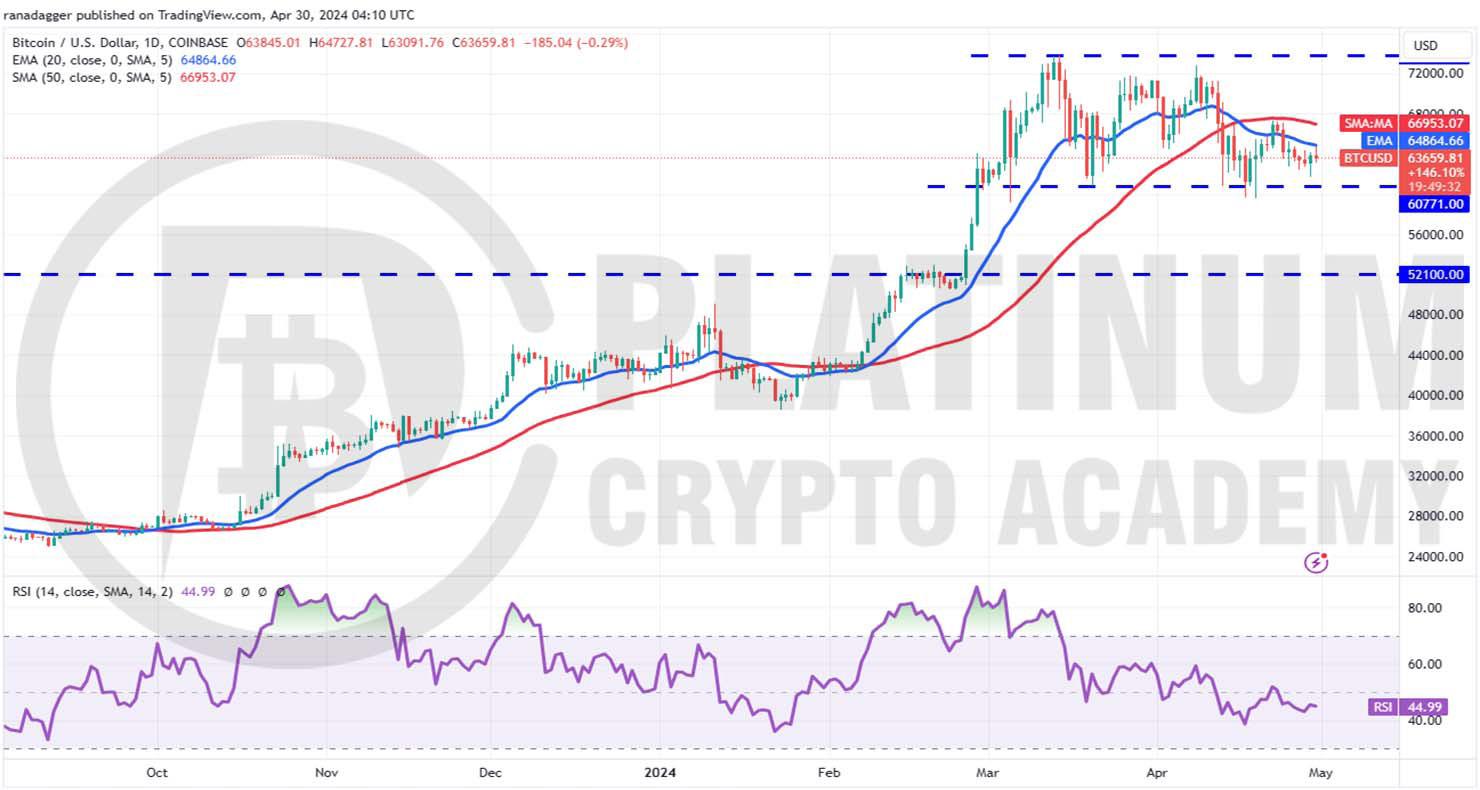
We said in the previous analysis that if the price rebounds off the $59,224 level, then Bitcoin may stay range-bound for some more time, and that is what happened.
The BTC/USD pair bounced off $59,573 on April 19, but the bulls could not clear the overhead resistance at the 50-day simple moving average (SMA). This suggests that the bears are selling on rallies.
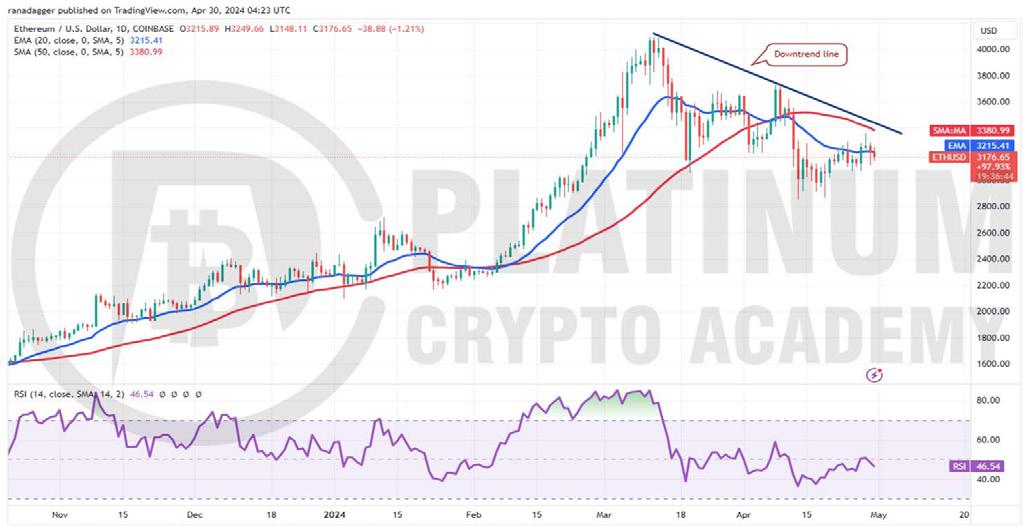
Ether pulled back from $2,865 on April 19, but the recovery hit a wall at the 50-day SMA. This suggests that the bears are active at higher levels. The bears will again try to sink the price below the solid support at $2,850.
The downsloping 20-day exponential moving average (EMA) and the relative strength index (RSI) just below the midpoint suggest a minor advantage to the bears. The sellers will make one more attempt to sink the pair below $59,224. If they succeed, the decline could extend to $52,100 where the buyers may step in to arrest the fall. A deeper correction could delay the start of the next leg of the uptrend.
On the other hand, if the price once again rebounds off $59,224, it will signal that the bulls are aggressively defending the level. The bulls will then make one more attempt to drive the price above the 50-day SMA. If they manage to do that, the pair may climb to the overhead resistance of $73,835. Buyers will have to clear this hurdle to start the next leg of the uptrend to $88,446.
Previous Analysis...
However, the flattening 20-day EMA and the RSI just below the midpoint suggest a range-bound action in the near term. The ETH/USD pair may swing between $2,850 and the downtrend line for a while.
A break and close below $2,850 will indicate that the bears have overpowered the bulls. That could start a downward move toward $2,700. This level is likely to attract strong buying by the bulls, but if the bears prevail, the pair may plummet to $2,165.
Contrarily, if the price turns up and breaks above the downtrend line, it will signal that the bulls are trying to make a comeback. The pair could then start a rally to $3,730, which is likely to act as a solid barrier.
Previous Analysis...
Cryptonaire Weekly | April 30 th 2024 6
BITCOIN - BTC/USD
ETHEREUM - ETH/USD

We mentioned in the previous analysis that Binance Coin is likely to remain range-bound if the $495 level holds, and that is how it has been.
RIPPLE - XRP/USD
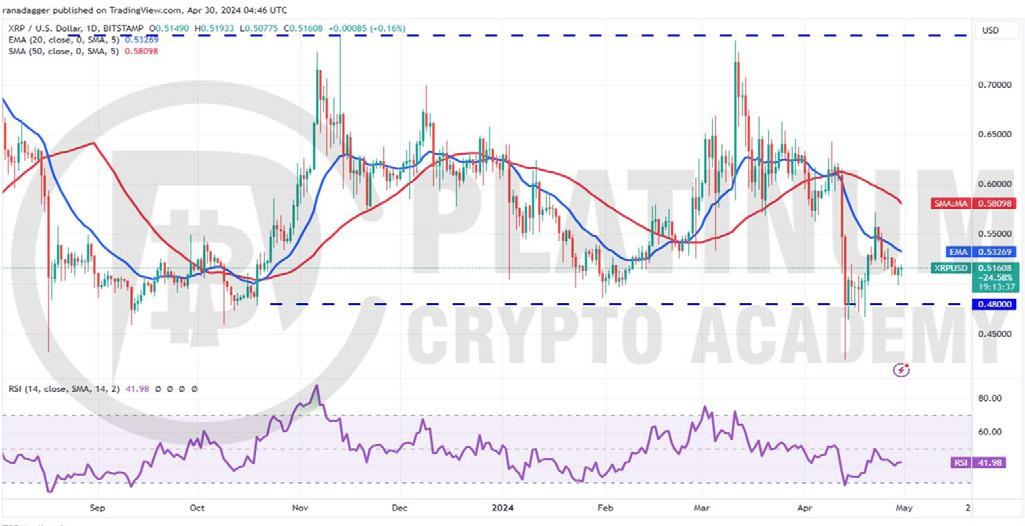
The repeated failure of the bears to sustain XRP below the $0.48 support started a recovery that rose above the 20-day EMA on April 22. However, the bulls could not maintain the higher levels, and
CARDANO - ADA/USD
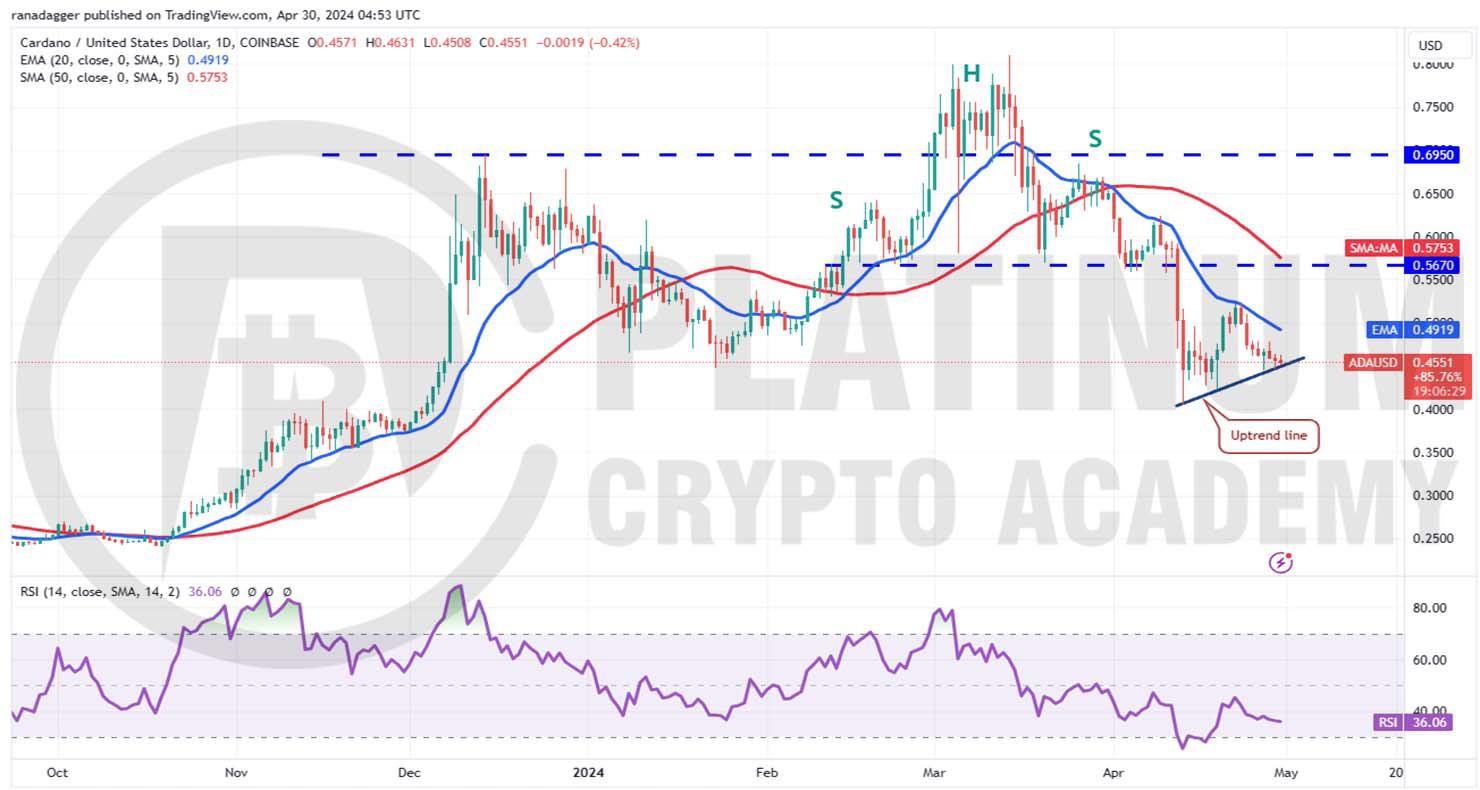
Cardano attempted a recovery, which hit a wall at the 20-day EMA. This suggests that the trend remains negative, and traders are viewing the rallies to the 20-day EMA as a selling opportunity.
The BNB/USD pair bounced off $512 on April 17 and started a relief rally, but that stalled at $618. This suggests that the pair is facing selling near the $635 resistance.
The price has dipped to the moving averages, an essential support to watch out for in the short term. If the price rebounds off the moving averages, the bulls will again try to overcome the obstacle at $635. If they manage to do that, it will indicate the resumption of the uptrend. The pair could then climb to $692.
Contrary to this assumption, if the price turns down and breaks below the moving averages, it will signal that the range-bound action may continue for a few more days. The bears will gain the upper hand if they sink and maintain the price below $495.
Previous Analysis...
the price turned back below the 20-day EMA on April 23. This shows that the sentiment remains negative, and traders are selling on rallies.
The XRP/USD pair could again descend to the vital support zone of $0.48 to $0.42. Buyers are likely to defend this zone with all their might because a break below it could start a new downtrend. The next support is at $0.35 and then $0.30.
On the upside, the bulls will have to clear the $0.57 resistance to indicate that the selling pressure could be reducing. The pair may then attempt a rally to $0.65. Such a move will suggest that the pair may spend some more time inside the large range between $0.48 and $0.75.
Previous Analysis...
The bulls are trying to defend the uptrend line, but the weak bounce shows a lack of aggressive buying. This increases the possibility of a fall to the crucial support at $0.40. If this support holds, it will indicate that the bulls are vigorously defending the level. That could start a relief rally toward $0.52.
A break and close above $0.52 will signal that the corrective phase may be over. The ADA/USD pair may then jump to $0.57 and subsequently to $0.62.
Contrarily, a fall below $0.40 will signal the resumption of the downtrend. The pair could then plunge to $0.35.
Previous Analysis...
Cryptonaire Weekly | April 30 th 2024 7
BINANCE - BNB/USD
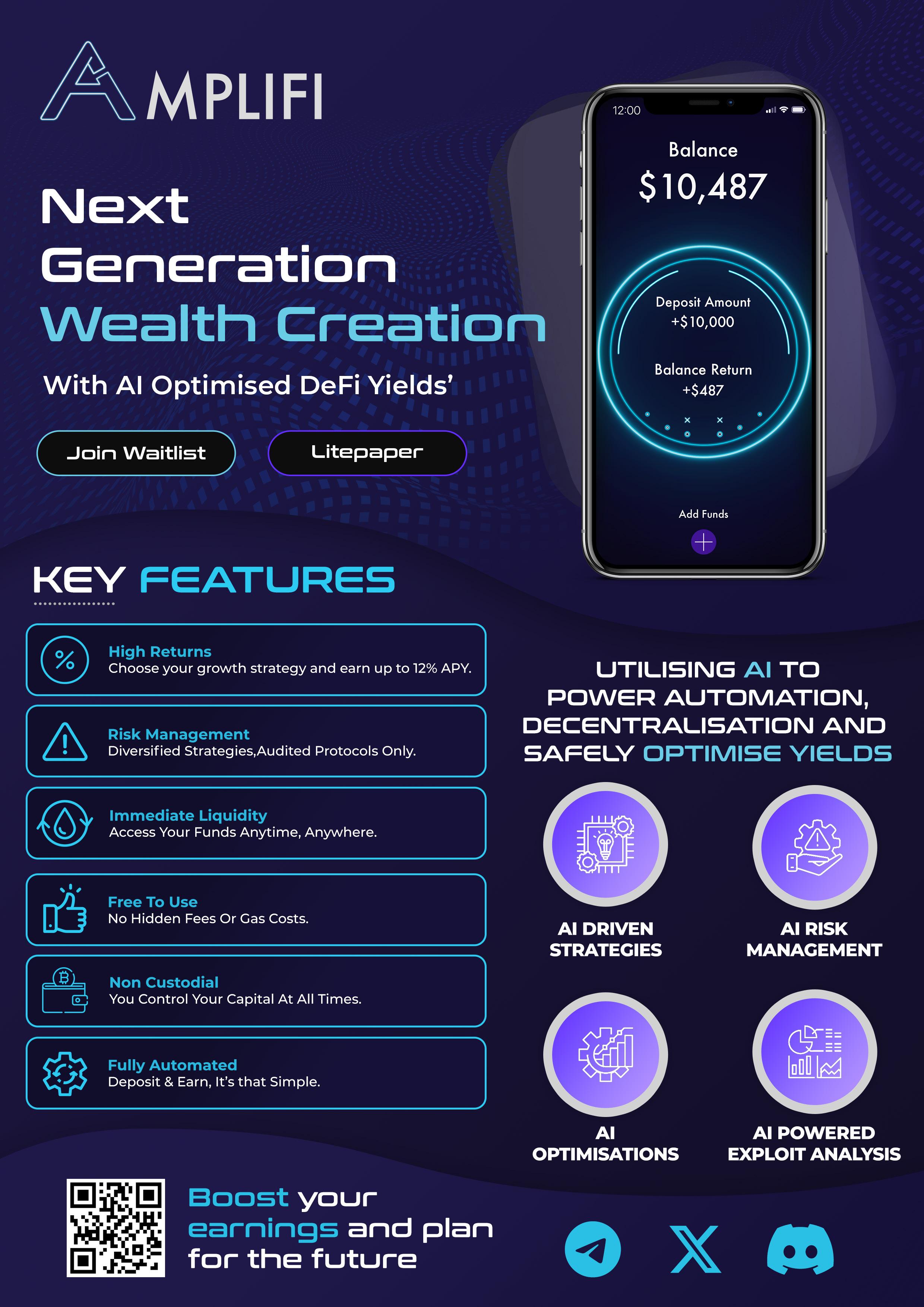
PRESS RELEASE
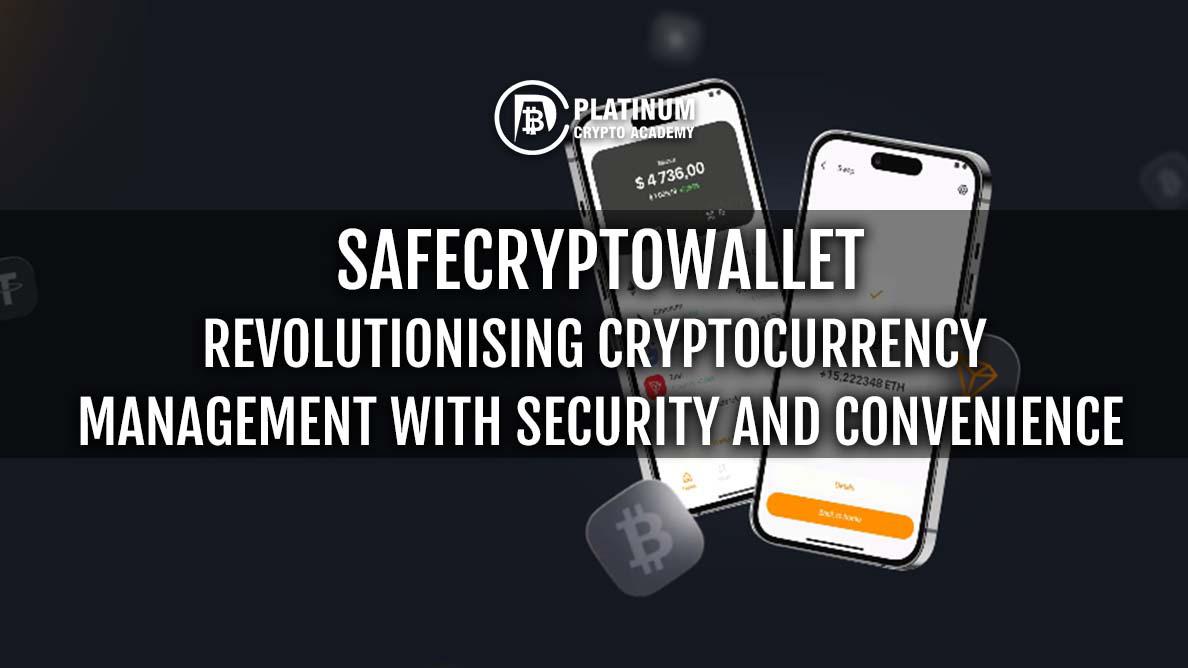
SafeCryptoWallet , a leading developer of cryptocurrency management solutions, is thrilled to announce the launch of its flagship product, SafeCryptoWallet. Designed to provide users with a secure and user-friendly platform for managing digital assets, SafeCryptoWallet offers unparalleled features and functionality.
AccordingtothespokespersonatSafeCryptoWallet:
In today’s fast-paced cryptocurrency landscape, security and convenience are of utmost importance. SafeCryptoWalletaddressestheseneedsbyoffering a non-custodial wallet solution for cold storage and management of cryptocurrencies. Available on both iOS and Android platforms, SafeCryptoWallet ensures that users can access their assets anytime, anywhere. The Android platform will be released by the end of this month and available for our users very soon.
Features and Functionality
SafeCryptoWallet provides a comprehensive set of features to streamline your cryptocurrency experience:
Send and Receive Cryptocurrencies: Seamlessly send and receive various cryptocurrencies with just a few taps, making transactions effortless and efficient.
Transaction Viewing: Keep track of your transaction
history with ease, gaining insight into your asset movements whenever you need it.
Unique Features
Our wallet stands out from the crowd with its distinctive attributes:
Multi-Currency Support: Enjoy the flexibility of managing multiple cryptocurrencies within a single wallet, eliminating the need for multiple applications.
Built-in Exchange Function: Exchange cryptocurrencies and tokens directly within the application, saving time and reducing hassle.
Customizable Address Generation: Generate unique wallet addresses with personalized patterns, enhancing security and anonymity.
Customisable Interface: Tailor your experience with SafeCryptoWallet by choosing between dark and light modes, optimizing visibility and comfort.
Cooperation Offer: We invite you to join us in a mutually beneficial partnership to promote SafeCryptoWallet to your audience. Our cooperation offer includes:
Payment for each download via the provided link, ensuring a fair compensation model.
Monthly fixed payments to support your efforts in promoting our product.
Cryptonaire Weekly | April 30 th 2024 9
Exclusive bonuses such as merchandise and personalized terms of use.
Collaborative opportunities such as podcasts with our developers and advertising integrations across your social networks.
SafeCryptoWallet is not just a product; it’s a commitment to empowering individuals with the tools they need to manage their cryptocurrencies securely and efficiently. We look forward to discussing the details of our cooperation further and embarking on a journey that benefits both you and your audience. Thank you for considering SafeCryptoWallet as your trusted partner in the world of cryptocurrency management.
About SafeCryptoWallet
Safe Crypto Wallet is a leading developer of cryptocurrency management solutions, offering a non-custodial wallet for the secure storage and management of digital assets. With a user-friendly interface and innovative features, SafeCryptoWallet aims to simplify cryptocurrency management for users worldwide.
For more information about SafeCryptoWallet, please visit: https://safecryptowallet.io/
Contact now for latest offers:
Email ID: pr@safecryptowallet.io
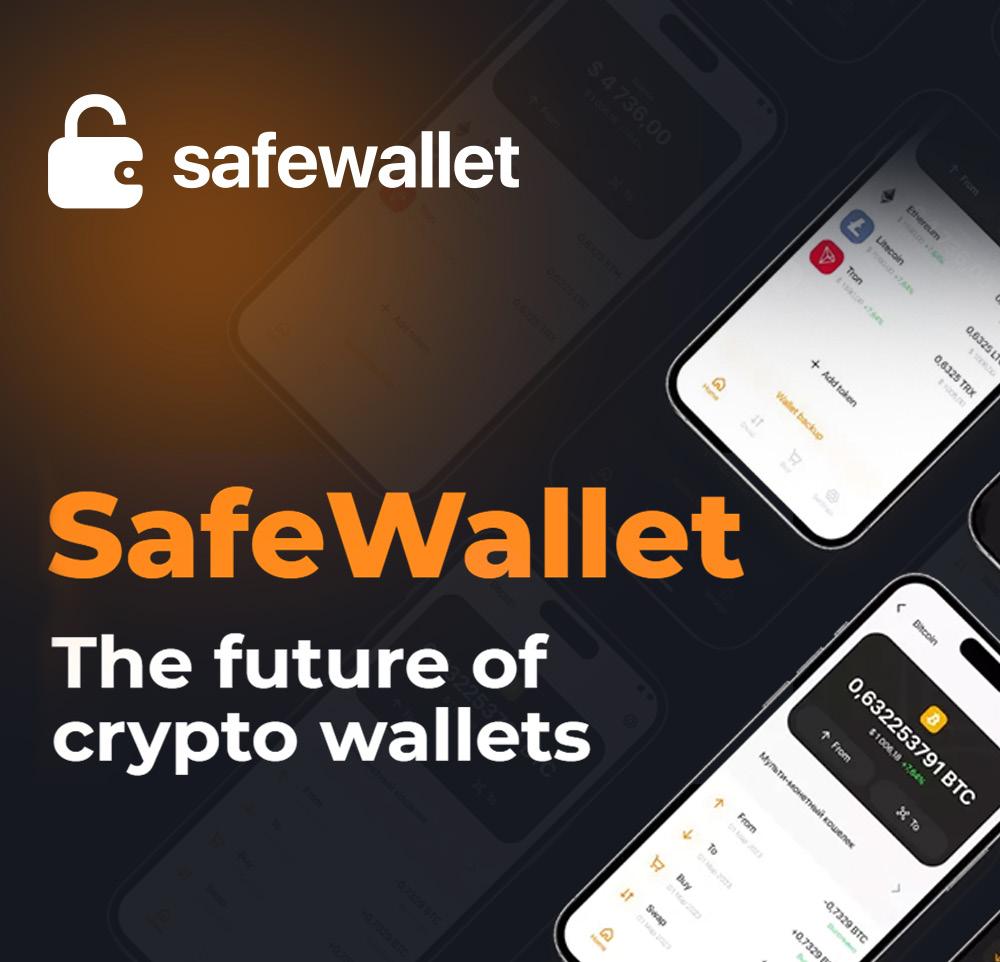
Cryptonaire Weekly | April 30 th 2024 10

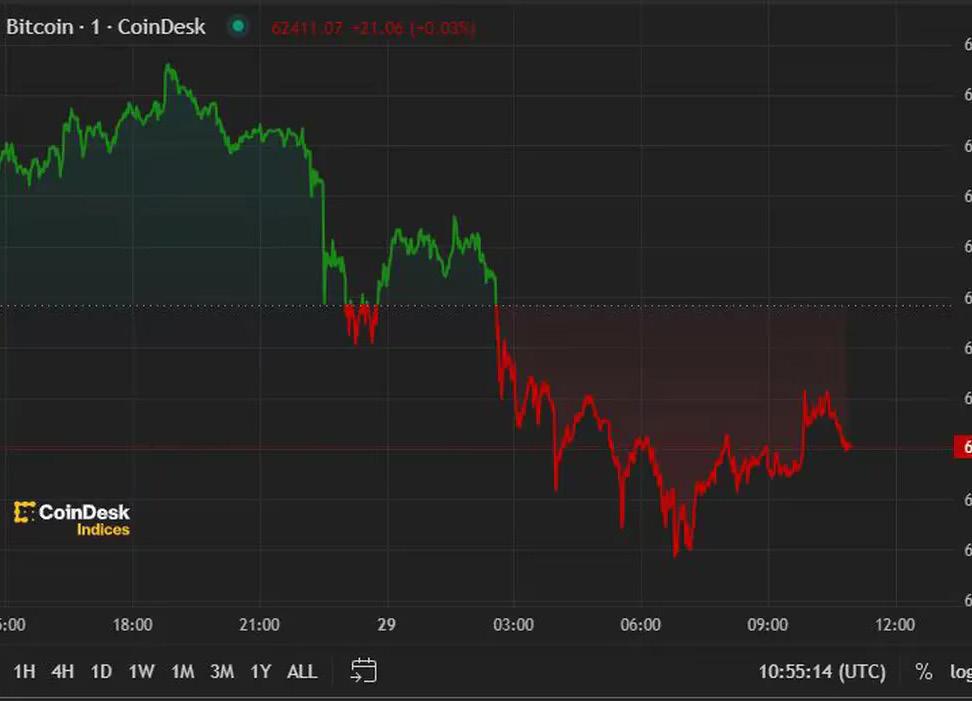
ADVANCEMENTS IN THE CRYPTOCURRENCY WORLD
FIRST
MOVER AMERICAS: BITCOIN, ETHER SINK AMID U.S. STAGFLATION FEARS
The latest price moves in crypto markets in context for April 29, 2024.
Bitcoin and ether dipped during the Asian morning on Monday amid renewed fears of U.S. stagflation. Bitcoin was down around 2% at $62,345 at the time of writing, while ether was 4% lower at $3,170.
The CoinDesk 20 (CD20), a measure of the most liquid digital assets, was also down around 4%."The weaker than expected [U.S.] GDP print points to a more sluggish economy while the higher Core PCE warns of an inflation problem that continues to be a thorn in the Fed's side," QCP wrote in a note over the weekend. The stagflationary combination of slower growth rate and sticky inflation has further weakened the probability of the Fed rate cuts.
Slowdown in bitcoin ETF inflows is a short-term pause and not the beginning of a negative trend, broker Bernstein wrote in a research report on Monday. “There is a natural gestation time to bitcoin becoming an acceptable portfolio allocation recommendation and the platforms establishing the compliance framework to sell bitcoin ETF products,”
analysts Gautam Chhugani and Mahika Sapra wrote. The broker added that there is no clear momentum up or down in bitcoin, which has been largely rangebound since the halving. Bernstein's expectation is that BTC hits a cycle high of $150,000 by 2025, owing to "unprecedented ETF demand inflows."
The first spot bitcoin ETFs could be approved in Australia by the end of the year, Bloomberg reported. At least two entities - DigitalX andVanEck - have applied to list such funds with the Australian Securities Exchange and another one is working on it, according to the report. ASX accounts for 90% of the Australian enquiry market. Its smaller rival Cboe Australia received an application to list a spot BTC ETF earlier this month from Monochrome Asset Management. Momentum for bitcoin ETFs has been building in the Asia-Pacific region for some months, culminating in Hong Kong officially approving the first batch of funds last week.
The chart shows daily active NFT users on Solana and Bitcoin over the past four weeks.
Read more...
Cryptonaire Weekly | April 30 th 2024 12

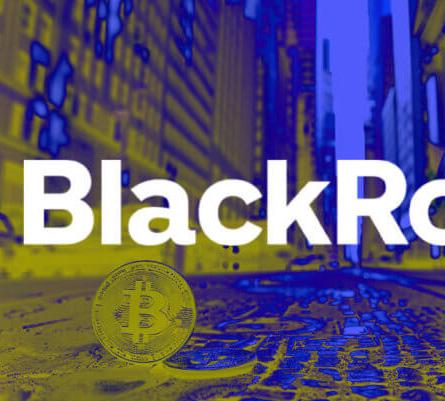
Investor sentiment for Bitcoin ETFs cools as Fidelity sees first outflows
BlackRock see back-to-back zero flows as Fidelity’s FBTC records first outflow.
Investor interest in spot Bitcoin exchange-traded funds (ETFs) appears to be waning, with outflows totaling $218 million in the past day.
According to data from Farside Investors, BlackRock’s IBIT Bitcoin ETF experienced its second consecutive day of zero flows, while Fidelity’s FBTC saw its first daily net outflow, totaling $23 million.
Other US Bitcoin funds experienced notable daily outflows. Grayscale GBTC fund continued its outflow trend, losing $139.37 million, while $31.34 million exited Ark Invest and
Tether, USDC and DAI transaction volume surpasses Visa's 2023 monthly average: Nansen
Transaction volume in the past 30 days for Tether, USDC, and DAI, has surpassed Visa’s 2023 monthly average, according to Nansen.
Crypto's three largest stablecoins — Tether USDT -0.12% , USDC and DAI — have seen higher volumes in the past 30 days than Visa’s average monthly
total from last year, according to onchain specialist Nansen.
Nansen data showed that the largest stablecoin by market capitalization, Tether, processed $654 billion in the past 30 days, while DAI managed over $394 billion of flows and USDC saw $321 billion in trading volume.
21Shares’ ARKB fund. Additionally, Valkyrie’s fund experienced $20.16 million in outflows, and Bitwise saw a negative flow of $6 million.
In contrast, Franklin Templeton’s EZBC emerged as the only fund with daily net inflows, attracting $1.87 million.
Despite these outflows, net inflows into the ETFs have surpassed $12 billion since their launch in January.
Earlier in the week, James Butterfill, CoinShares’ Head of Research, explained that these outflows signal waning interest among ETP/ETF investors, fueled by speculations about potential delays in rate cuts by the Federal Reserve.
Read more...
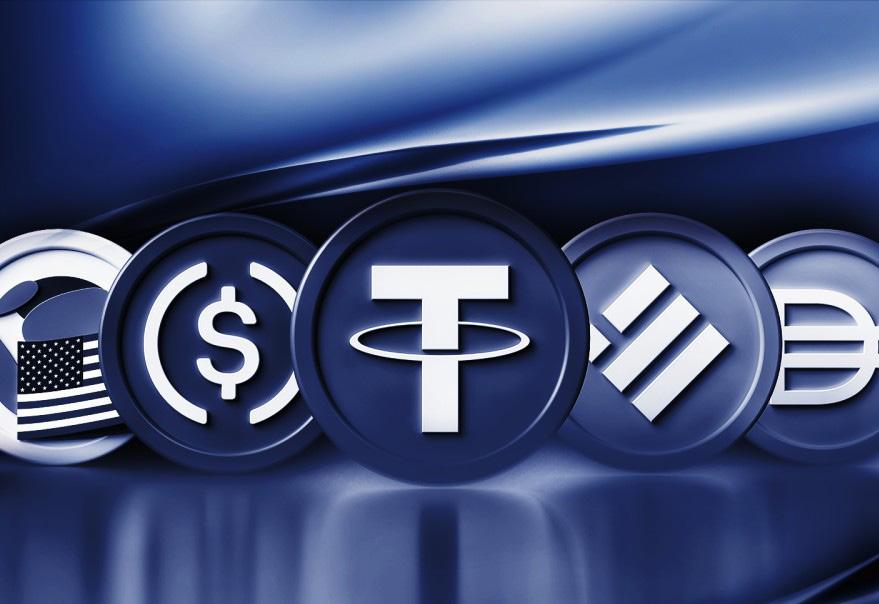
"The total for the three at $1.369 trillion is higher than the monthly average for market leader Visa in 2023," said Nansen. That compares to $1.23 trillion, the monthly average of Visa's yearly $14.8 trillion volume in 2023.
Nansen’s data showed that Tether alone processed nearly as much in monthly volumes as Mastercard, the second largest card provider in the world. Mastercard’s monthly average vol-
umes were $750 billion in 2023, totaling $9 trillion for the year. Data showed that Tether also outstripped PayPal, which managed $125 billion on average each month last year.
USDC takes lead in stablecoin transactions, Visa claims
In an April report, Visa claimed that Circle’s USDC should be classed as the leading stablecoin in terms of transactions volume.
Read more...
Cryptonaire Weekly | April 30 th 2024 14
SPONSORED PRESS RELEASE

Yue Minjun Revolutionizes Bitcoin Art Scene with Pioneering Ordinals Collection on LiveArt
NEW YORK, United States, April 30th, 2024, Chainwire
The first major contemporary artist to adopt the Bitcoin blockchain
LiveArt proudly unveils Human by Yue Minjun, the first-ever Ordinals collection from a contemporary art giant.

The VR Project SimuGaze Presale Goes Live Today
Grundsheim, germany, April 29th, 2024, Chainwire
Today marks an important date in the world of realistic simulation and virtual racing as Simugaze, the highly awaited cryptocurrency-powered ecosystem, officially launches. The SimuGaze ecosystem aims to transform the virtual gaming industry and realistic simulation by offering dynamic, immersive engagement to its users and investors and exciting rewards for racing enthusiasts worldwide.

MetaWin Founder Launches $ROCKY Meme Coin on Base Network
London, United Kingdom, April 29th, 2024, Chainwire
An exciting new meme coin, $ROCKY, has recently debuted on the Base network. Skel.eth, the founder of MetaWin, launched the coin last weekend. Intriguingly, the coin is named after his Pomeranian, also named ROCKY.
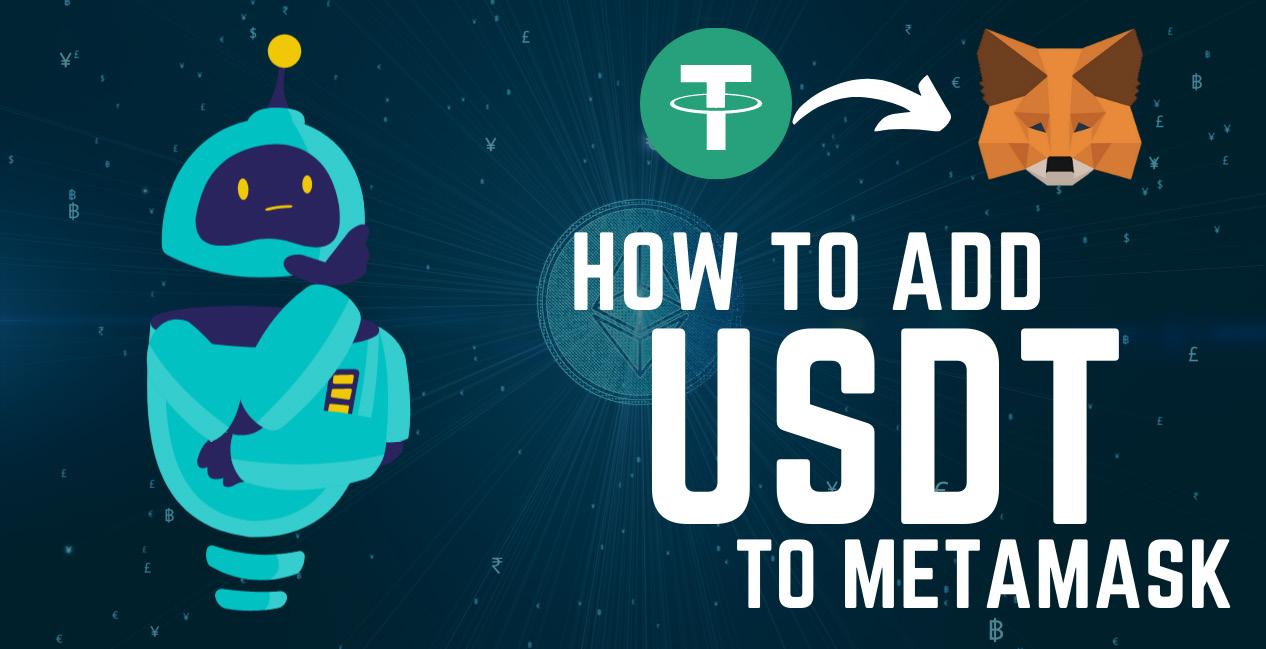
A Complete Guide to Add USDT to MetaMask Wallet?
MetaMask stands as one of the most widely used cryptocurrency wallets worldwide, acclaimed for its user-friendly interface and robust security measures. Operating as both a browser extension and a mobile app, MetaMask serves as a gateway for users to engage with Ethereum’s decentralized ecosystem and other compatible networks. It facilitates easy access to decentralized applications (DApps), token swaps, and the broader Web3 environment.
Cryptonaire Weekly | April 30 th 2024 15
Read more...
more... Read more... Read more...
Read
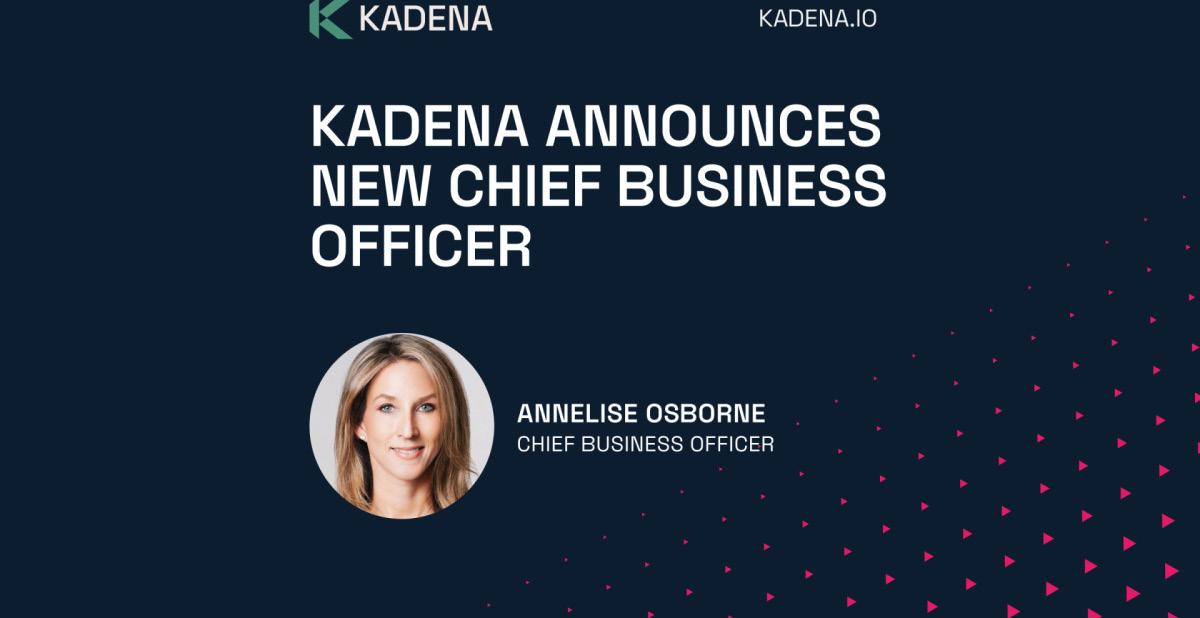

Kadena Announces Annelise Osborne as Chief Business Officer Proof
New York, New York, April 25th, 2024, Chainwire Kadena, the only scalable Layer-1 Proof-of-Work blockchain, expands its leadership team by onboarding Annelise Osborne as Kadena’s new Chief Business Officer (CBO). With an illustrious career spanning over 20 years in finance, credit, real estate, and digital assets, Annelise will be responsible for developing and leading new business initiatives and partnerships across Web3 and beyond.

Paris, France, April 25th, 2024, Chainwire Prize pool of over 1M€ value including media grant from Cointelegraph Proof of Pitch is part of Proof of Talk, where All Global Leaders in Web3 Meet
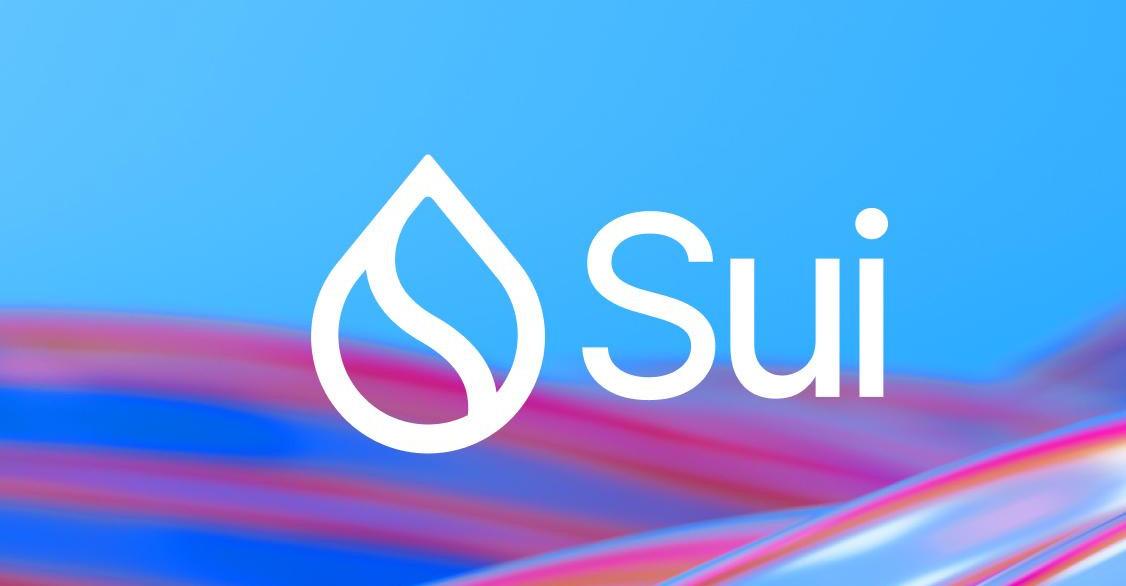
Dubai, United Arab Emirates, April 24th, 2024, Chainwire
“Yoki Origins,” supported by Bandit Network and Brave Ads, introduces a gamified and rewarding experience for Astar zkEVM users, marking a significant milestone in Web3 adoption.
Grand Cayman, Cayman Islands, April 18th, 2024, Chainwire
The annual event is a culmination of Sui’s exceptional debut. Over 1,000 projects, partners, investors, and enthusiasts from 65 countries around the world gathered last week in Paris.
Read more...
Cryptonaire Weekly | April 30 th 2024 16
Revolutionizing the Pitch Competition Landscape with AI-Driven
Bandit Network’s Points SDK and Brave Ads Power Astar zkEVM’s Quest Platform “Yoki Origins” Read more... Read more... Read more...
of Pitch:
Insights and Top Web3 VC
Over 1,000 Builders, Partners, Investors and Enthusiasts Gather at Inaugural Global Event to Celebrate Sui

New mix of bitcoin buyers bode well for ecosystem: Franklin Templeton exec
More institutions are allocating to bitcoin ETFs with the long term in mind, according to Franklin Templeton’s Christopher Jensen — though education remains a work in progress
Franklin Templeton’s crypto-focused research director remains optimistic about the future of the space despite recent outflows from bitcoin ETFs.
In an interview with Blockworks, Christopher Jensen highlighted the emergence of new buyer types as a positive indicator for long-term growth.
Jensen also said the recent Bitcoin halving exposed gaps in clients’ understanding of cryptocurrency.
Stablecoin firm Tether invests $200M in neurotech company
Tether’s brand new division, Tether Evo, has completed a $200 million strategic investment in the neural implant firm.
Tether — the operator of the eponymous Tether USDT $1.00 stablecoin, the world’s largest stablecoin by market value — has completed a major investment following
restructuring of its business.
On April 29, Tether announced a strategic investment of $200 million into Blackrock Neurotech, becoming the majority stakeholder in the neural implant company. The investment was carried out through Tether Evo, a brand-new division at Tether focused on the intersection of
He emphasized Franklin Templeton’s commitment to bridging these educational shortfalls, aiming to increase client knowledge and engagement in Web3.
This need for education comes at what could prove a critical time for the US bitcoin ETF market. The US boasts 11 spot bitcoin ETF funds, which allow participants to gain bitcoin exposure via traditional investment vehicles without buying and holding the crypto asset themselves.
Despite seeing $12 billion of net inflows to date, these funds have collectively endured net outflows across three straight weeks for the first time since launching in January.
Read more...
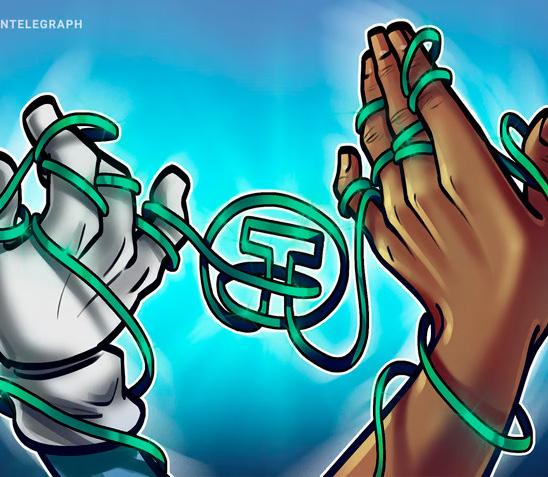
human potential and technology.
Established in 2008, Blackrock Neurotech is a global pioneer of human braincomputer-interface (BCI) technology, known for its advanced braincomputer interfaces.
The firm is committed to helping millions of people around the world afflicted with paralysis, lost function and neurological disorders that prevent them from walking, seeing, hearing, feeling or talking.
Through Blackrock Neurotech’s brain interface technology, patients have operated robotic arms, maneuvered wheelchairs, sent messages, surfed the internet, and even driven a car using the power of their thoughts.
Read more...
Cryptonaire Weekly | April 30 th 2024 17

Payments Giant Stripe Expands Crypto Return With Avalanche Integration
Bitcoin mining has provided a “positive contribution to Paraguay’s trade balance,” and a ban could dent the economy, argues Hashlabs Mining’s co-founder.
Stripe's new Avalanche integration means that users can buy AVAX directly through the mobile app—without having to go through an exchange.
Payments processor Stripe is going all in on crypto, it seems, as it today announces its integration of Avalanche.
Just last week, the San Francisco-based firm announced it was allowing companies that use its technology to accept USD Coin (USDC) stablecoin for online payments.
Bitcoin Whale Aggressively Accumulates $282,380,000 Worth of BTC During Correction: On-Chain Data
ABitcoin whale has stacked over $282 million in BTC since late March as the flagship digital asset struggles to find a bottom after hitting alltime highs.
And today, it said that its retail customers will have easier access to the Avalanche ecosystem. Ava Labs, the development company behind the Avalanche blockchain, said its wallet, Core, would use Stripe’s fiat-to-crypto onramp.
In short, the integration will allow users to seamlessly access usually niche crypto products and decentralized apps like decentralized exchanges and NFT platforms that run on Avalanche.
A widget will be installed in Core allowing anyone to buy Avalanche’s native AVAX coin using debit or credit cards, without going through an exchange. Stripe will take care of all things related to KYC, the announcement read.
Read more...
First spotted by blockchain tracking firm Lookonchain, an address beginning with “12QVsfA” bought 4,380 BTC worth $282.38 at an average price of $64,471.
Says Lookonchain, “After the price of BTC dropped, this whale bought another 620 BTC ($39.8 million) at the bottom.
Since March 21, this whale has bought 4,380 BTC ($282.38 million) at $64,471 from Binance.
On the same day, the firm also spotted
another whale depositing over $77.67 million worth of Bitcoin into crypto exchange Kraken. While it’s unclear what the whale plans to do with their coins, depositing them onto Kraken means they could potentially sell the BTC on the open market.
Citing data from crypto “de-anonymizing” service Arkham, Lookonchain says the entity has accumulated over $1.68 billion worth of Bitcoin in just a month and a half.
“A whale deposited 1,200 BTC ($77.67 million) into Kraken 43 minutes ago.
At time of writing, Bitcoin is trading at $63,315, 14% down from its all-time high of $73,737.
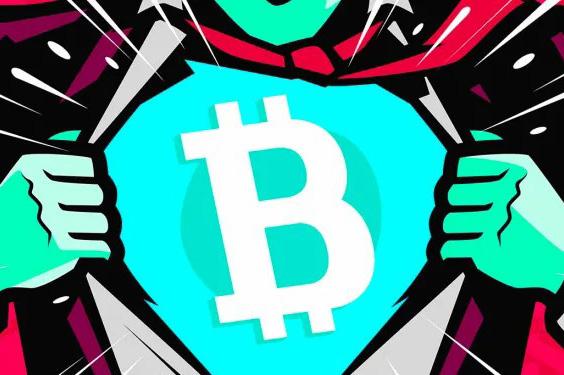
Read more...
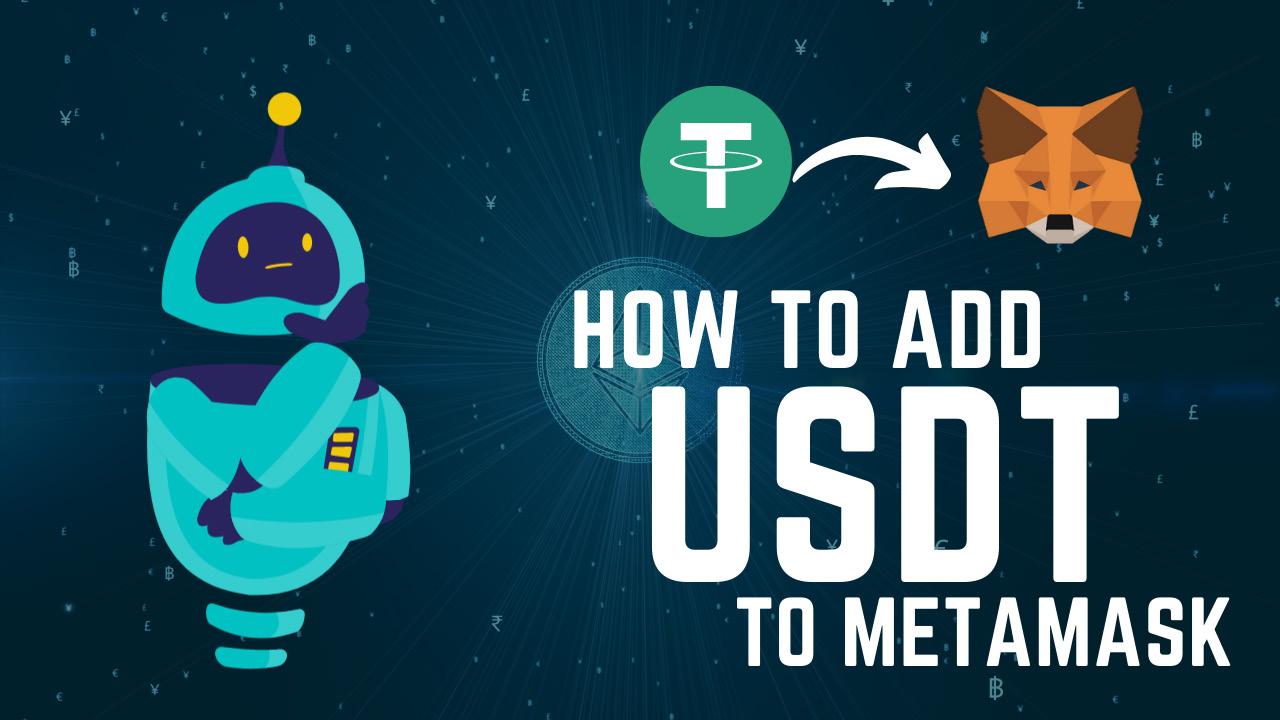
MetaMask stands as one of the most widely used cryptocurrency wallets worldwide, acclaimed for its user-friendly interface and robust security measures. Operating as both a browser extension and a mobile app, MetaMask serves as a gateway for users to engage with Ethereum’s decentralized ecosystem and other compatible networks. It facilitates easy access to decentralized applications (DApps), token swaps, and the broader Web3 environment.
On the other hand, Tether is a cornerstone of the stablecoin market, aiming to provide a digital asset pegged to the value of the United States dollar. Its role in the crypto market is crucial, acting as a bridge between fiat and cryptocurrencies.
With its integration into MetaMask, Tether (USDT) opens up a myriad of opportunities for users to leverage its stability within their digital asset portfolios. This allows for faster and more costeffective transactions compared to traditional banking systems.
This article offers an overview of the steps required to move USDT to MetaMask, including the procedure for adding USDT to MetaMask, receiving USDT in MetaMask, tracking USDT transactions, and troubleshooting common issues encountered when using USDT with MetaMask.
Requirements prior to transferring USDT to MetaMask wallet
Before integrating USDT into the MetaMask wallet, several prerequisites must be met:
Installation of MetaMask
Installing MetaMask is the crucial first step in the process, allowing users to access its features across multiple platforms. MetaMask is available as a browser extension for popular browsers like Chrome, Firefox, and Brave, providing seamless integration into users’ web browsing experiences. Additionally, it offers a dedicated mobile application for both Android and iOS platforms, ensuring accessibility on the go. To install MetaMask, users can visit the official MetaMask website or navigate to the respective app stores on their mobile devices. Once downloaded, the setup procedure involves installing the application and creating a wallet, setting the foundation for managing digital assets securely and conveniently.
Ensuring Wallet Security
Following the installation of MetaMask, it is imperative to take measures to secure your wallet. The first step is to establish a robust password, ensuring that it is unique and difficult to guess. This password acts as a crucial line of defense against
Cryptonaire Weekly | April 30 th 2024 19
unauthorized access to your wallet. Additionally, during the setup process, MetaMask generates a secret recovery phrase. This phrase, also known as a seed phrase, is a series of words that serve as a backup to your wallet. It’s essential to securely document and store this recovery phrase in a safe and accessible location. The recovery phrase serves as the exclusive method to regain access to the wallet in instances of forgotten passwords or lost device access. It’s important to treat this recovery phrase with the utmost care, as anyone with access to it can potentially gain control of your wallet and digital assets. By ensuring the security of your password and recovery phrase, you can safeguard your MetaMask wallet against unauthorized access and protect your digital assets from potential threats.
Wallet Funding with ETH
Before incorporating USDT into your MetaMask wallet, it’s essential to ensure that you have Ethereum’s native cryptocurrency, Ether (ETH), available to cover transaction fees, commonly known as “gas.” These transaction fees are necessary for executing smart contracts and interacting with decentralized applications (DApps) on the Ethereum network. Without sufficient ETH in your MetaMask wallet, you won’t be able to complete transactions involving USDT or other Ethereum-based tokens.
To obtain ETH, users can purchase it from a cryptocurrency exchange and then transfer it to their MetaMask wallet address. Here’s how:
Purchase ETH from a reputable cryptocurrency exchange such as Coinbase, Binance, or Kraken. Users can buy ETH using fiat currency or other cryptocurrencies like Bitcoin (BTC) or Tether (USDT).
Once the purchase is complete, navigate to the withdrawal or transfer section of the exchange.
Enter your MetaMask wallet address as the destination address for the ETH withdrawal.
Double-check the wallet address to ensure accuracy, as sending ETH to the wrong address could result in permanent loss of funds.
Confirm the withdrawal and wait for the ETH to be transferred to your MetaMask wallet. Depending
on network congestion, this process may take a few minutes to several hours.
Once the ETH is successfully transferred to your MetaMask wallet, you’ll be ready to proceed with adding USDT and engaging in transactions on the Ethereum network. Having a sufficient amount of ETH in your wallet ensures that you can pay for gas fees and execute transactions smoothly without any interruptions.
How to Add Tether (USDT) to MetaMask?
MetaMask, one of the most popular cryptocurrency wallets, provides users with a seamless way to interact with the decentralized web. While initially focused on Ethereum, MetaMask has evolved to support various Ethereum-compatible networks, allowing users to manage a wide range of digital assets. Adding Tether (USDT), a leading stablecoin, to MetaMask can enhance its functionality and provide users with access to stable digital assets. Let’s walk you through the step-by-step process of adding USDT to your MetaMask wallet.
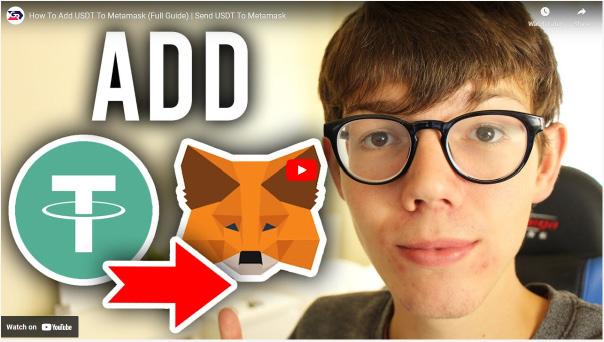
1. Understand Tether (USDT)
Before adding USDT to your MetaMask wallet, it’s essential to understand what Tether is and how it works. Tether (USDT) is a stablecoin pegged to the value of the US dollar, meaning that 1 USDT is intended to be equivalent to $1 USD. It operates on various blockchain networks, including Ethereum, Tron, and others, allowing users to transact in a stable digital currency without the volatility associated with other cryptocurrencies.
2. Ensure You Have MetaMask Installed
The first step is to ensure that you have MetaMask installed on your browser or mobile device. If you haven’t already installed MetaMask, you can do so by following these steps:
Cryptonaire Weekly | April 30 th 2024 20
For browsers: Visit the MetaMask website or search for MetaMask on the Chrome, Firefox, or Brave browser extensions store. Click on the “Add to Chrome” (or equivalent) button and follow the instructions to install the extension.
For mobile devices: Download the MetaMask app from the Google Play Store (for Android) or the App Store (for iOS). Follow the prompts to install the app on your device.
3. Set Up Your MetaMask Wallet
Once MetaMask is installed, you’ll need to set up your wallet. Here’s how:
Open MetaMask and click on “Get Started.”
Create a new wallet or import an existing one using your seed phrase.
Set a strong password for your wallet and confirm it. MetaMask will then generate a seed phrase (also known as a recovery phrase). Write down this seed phrase and store it in a safe place. This phrase is crucial for recovering your wallet if you forget your password or lose access to your device.
4. Add ETH to Your MetaMask Wallet
Before you can add USDT to your MetaMask wallet, you’ll need to ensure that you have some Ether (ETH) to cover transaction fees. Here’s how to add ETH to your MetaMask wallet:
Click on the “Buy” button within MetaMask or navigate to an exchange where you can purchase ETH.
Purchase ETH using your preferred payment method.
Once you have purchased ETH, you can transfer it to your MetaMask wallet address. To do this, copy your MetaMask wallet address and use it as the recipient address when making the transfer.
5. Find a Suitable Exchange to Buy USDT
To acquire USDT, you’ll need to find a reputable cryptocurrency exchange that supports USDT trading. Some popular exchanges where you can buy USDT include Binance, Coinbase, Kraken, and Bitfinex. Here’s how to buy USDT on Binance, one of the largest cryptocurrency exchanges:
Sign up for a Binance account if you don’t already have one.
Complete the necessary verification steps to enable trading.
Deposit funds into your Binance account using your preferred payment method.
Once your account is funded, navigate to the USDT trading pair you want to use (e.g., BTC/USDT, ETH/ USDT).
Place a buy order for USDT at the current market price or set a limit order at your desired price.
Once your buy order is filled, you will have USDT in your Binance account.
6. Withdraw USDT to Your MetaMask Wallet
Once you have purchased USDT on the exchange, you’ll need to withdraw it to your MetaMask wallet. Here’s how to do it:
Log in to your Binance account and navigate to the “Withdraw” page.
Select USDT as the withdrawal currency and enter the amount you want to withdraw.
Paste your MetaMask wallet address into the recipient address field.
Double-check that the wallet address is correct, then confirm the withdrawal.
Binance will process your withdrawal, and the USDT will be sent to your MetaMask wallet.
7. Add the USDT Token to MetaMask
After receiving USDT in your MetaMask wallet, you’ll need to add the USDT token to your MetaMask interface. Here’s how to do it:
Open MetaMask and make sure you are on the main screen.
Click on the “Assets” tab.
Scroll down and click on “Add Token.”
Select “Custom Token” and enter the USDT contract address: 0xdac17f958d2ee523a2206206994597c13d831ec7 MetaMask should automatically fill in the token
Cryptonaire Weekly | April 30 th 2024 21
symbol as USDT and the decimals as 6. Click “Next” to continue.
Click “Add Tokens” to add USDT to your MetaMask wallet.
8. Confirm USDT Addition
Once you have successfully added the USDT token to your MetaMask wallet, you will find it listed under the “Assets” tab along with your other tokens. To verify that USDT has been successfully added to your wallet, simply navigate to the “Assets” tab and look for the USDT token. It should be displayed alongside any other tokens you have added.
Click on the USDT token to confirm its presence in your wallet. This action will open up a window displaying additional details about the token, including its current balance and transaction history. By reviewing this information, you can ensure that USDT has been correctly added to your MetaMask wallet and is ready for use in transactions and transfers.
Having USDT listed in your MetaMask wallet allows you to easily manage and track your stablecoin holdings alongside other digital assets. Whether you’re looking to send USDT to another wallet, use it in decentralized finance (DeFi) protocols, or simply monitor its value, having it readily accessible in MetaMask streamlines the process and enhances your overall cryptocurrency experience.
9. Track USDT Transactions in MetaMask
You can now utilize MetaMask to not only add USDT but also to send, receive, and track your USDT transactions effortlessly. To view your USDT transactions:
Open MetaMask and navigate to the “Activity” tab located within the interface.
In the “Activity” tab, you will find a comprehensive list of all your recent transactions, including those involving USDT.
Each transaction is displayed with key details such as the amount sent or received, the transaction status, and the date and time of the transaction.
To view more detailed information about a specific transaction, simply click on it. This will provide you with additional details such as the wallet addresses involved, gas fees paid, and the transaction hash.
You can use this information to track the progress of your transactions, verify their completion, or investigate any issues that may arise.
Now, you can easily monitor your USDT transactions directly within the MetaMask interface, providing you with greater visibility and control over your digital asset activities.
10. Troubleshooting Common Issues
If you encounter any difficulties while adding USDT to MetaMask, there are several common troubleshooting steps you can take:
Verify the Wallet Address: Ensure that you have entered the correct MetaMask wallet address when withdrawing USDT from the exchange. Any discrepancies in the address could result in the USDT being sent to the wrong destination, leading to potential loss of funds.
Double-Check the Contract Address: It’s essential to double-check that you have added the correct USDT contract address to MetaMask. Using an incorrect contract address may prevent MetaMask from recognizing USDT tokens in your wallet.
Refresh or Restart MetaMask: If USDT does not appear in your MetaMask wallet after adding it, try refreshing the page or restarting the MetaMask app. This action may help synchronize your wallet with the latest transaction data and display the newly added USDT tokens.
Reach Out to MetaMask Support: If you continue to experience issues despite following the above steps, don’t hesitate to contact MetaMask support for further assistance. The support team can provide guidance and troubleshooting tips tailored to your specific situation, helping you resolve any issues promptly.
By following these troubleshooting steps, you can address common issues encountered when adding USDT to MetaMask and ensure a smooth and seamless experience managing your digital assets on the platform.
Conclusion
Adding Tether (USDT) to MetaMask significantly enhances the functionalities of your wallet and grants you access to a stable digital asset. By following the step-by-step guide provided in this
Cryptonaire Weekly | April 30 th 2024 22
tutorial, you can seamlessly integrate USDT into your MetaMask wallet and leverage it for various purposes such as transactions, investments, or hedging against market volatility. With MetaMask’s intuitive interface and robust security features, managing your USDT holdings becomes not only effortless but also highly secure. Whether you’re a seasoned cryptocurrency investor or a newcomer to the digital asset space, MetaMask provides the tools and capabilities needed to navigate the world of decentralized finance (DeFi) with confidence and ease.
FAQs
1: Can I use MetaMask to store USDT?
Yes, MetaMask is compatible with various Ethereumbased tokens, including USDT. You can securely store USDT in your MetaMask wallet and manage it alongside other digital assets such as Ether (ETH), tokens, and decentralized finance (DeFi) assets. Storing USDT in MetaMask provides you with easy access to your funds and allows you to participate in various cryptocurrency activities directly from your wallet interface.
2: How do I add USDT to MetaMask?
Adding USDT to your MetaMask wallet involves a few steps. Firstly, you’ll need to acquire USDT from a cryptocurrency exchange that supports its trading. Once you have USDT in your exchange account, initiate a withdrawal and provide your MetaMask wallet address as the recipient. After the withdrawal is confirmed, USDT will be transferred to your MetaMask wallet. To add the USDT token to MetaMask, navigate to the “Add Token” section, enter the USDT contract address, token symbol, and decimals, and click “Add Token.”
3: Where can I find the USDT contract address for MetaMask?
The USDT contract address can typically be found on the official website of the token issuer or on
reputable cryptocurrency information platforms such as CoinGecko or CoinMarketCap. It’s crucial to ensure that you use the correct contract address to add USDT to MetaMask, as using an incorrect address may result in the loss of funds.
4: How long does it take for USDT to appear in MetaMask after adding it?
The time it takes for USDT to appear in your MetaMask wallet depends on several factors, including network congestion and transaction confirmation times. In most cases, USDT should appear in your MetaMask wallet within a few minutes to an hour after the transaction is confirmed on the Ethereum blockchain. However, during times of high network activity, it may take longer for transactions to be processed.
5: Can I send USDT from MetaMask to other wallets or exchanges?
Yes, once USDT is added to your MetaMask wallet, you can easily send it to other wallets or exchanges. Simply navigate to the “Send” section of your MetaMask wallet, enter the recipient’s wallet address, specify the amount of USDT you wish to send, and confirm the transaction. USDT transactions from MetaMask are processed on the Ethereum blockchain and typically require gas fees to be paid in Ether (ETH).
6: Is there a minimum amount of ETH required in MetaMask to cover gas fees for USDT transactions?
Yes, to send USDT or any other tokens from your MetaMask wallet, you’ll need to ensure that you have a sufficient amount of Ether (ETH) to cover gas fees. Gas fees are required to execute transactions on the Ethereum blockchain, including those involving USDT. The exact amount of ETH required depends on factors such as network congestion and gas prices at the time of the transaction. It’s advisable to maintain a balance of ETH in your MetaMask wallet to ensure smooth transaction processing.
Cryptonaire Weekly | April 30 th 2024 23
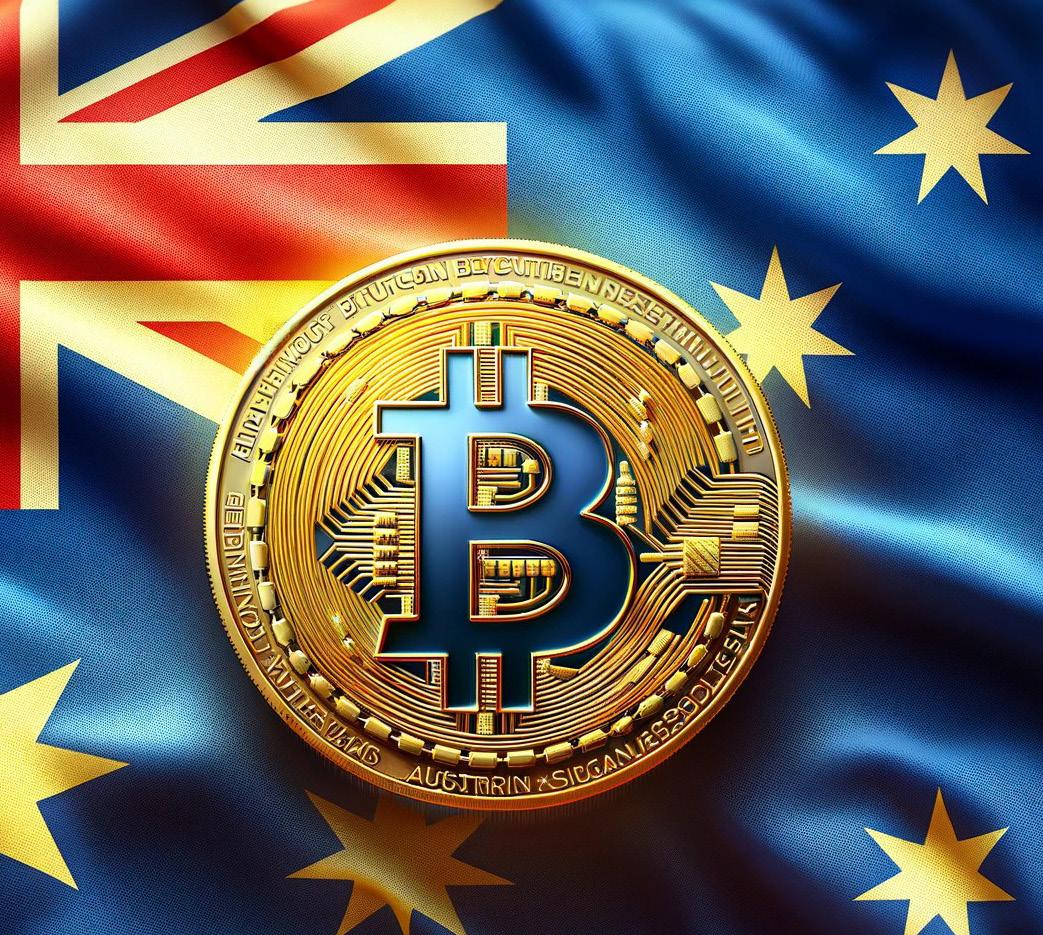
Spot Bitcoin ETFs Set To Hit Australia’s Stock Exchange In 2024
Australia is poised to welcome a series of spot Bitcoin exchange-traded funds (ETFs) on its main stock exchange by the end of 2024, mirroring initiatives previously seen in the United States and Hong Kong. Key players in the financial industry, including Van Eck Associates Corp. and BetaShares Holdings Pty, are actively preparing for these launches, with the Australian Securities Exchange (ASX) expected to grant approvals soon.
According to sources who wished to remain anonymous, ASX Ltd., which facilitates approximately 80% of the country’s equity trading, is anticipated to give the green light to the first spot Bitcoin
Yuga Labs Resumes Layoffs; CEO Says Web3 Platform ‘Lost
Its Way’
According to Greg Solano, co-founder of Yuga Labs, the Web3 platform has laid off additional workers partly because it had “lost its way.” Solano also encouraged employees uninterested in the next phase to consider accepting the same severance package offered to
those affected by the layoffs.
Convoluted Corporate Processes
Yuga Labs, the Web3 platform behind the popular non-fungible tokens (NFTs) Bored Ape Yacht Club (BAYC), recently announced new worker layoffs. The company eliminated several roles held by
ETFs before 2025. This development comes as the global interest in cryptocurrency ETFs grows, spurred by significant accumulations in similar funds in the United States, where players like BlackRock and Fidelity Investments dominate.
“The inflows into the US digital assets market prove that digital assets are here to stay,” stated Justin Arzadon, head of digital assets for BetaShares. He also mentioned that the firm has reserved ASX tickers for spot-Bitcoin and spot-Ether ETFs, signaling strong preparations for imminent listings.
An ASX spokesperson confirmed the exchange’s engagement with several issuers.
Read more...

its talented employees as part of this strategic move.
Co-founder and CEO Greg Solano explained that Yuga Labs had “lost its way,” prompting the need for change. The goal is to return the company to a more streamlined and agile team with a strong focus on crypto-native projects, Solano added.
In a statement shared via X, Solano, who resumed his role as CEO in February, also high-
lighted how his analysis of Yuga Labs’ current state had identified some of the problems affecting it. For instance, Solano said he found the company had convoluted corporate processes that had diluted the creative spirit that had fueled its success since inception.
Before these recent layoffs, Yuga Labs had parted ways with approximately 120 U.S.based employees during the last quarter of 2023.
Cryptonaire Weekly | April 30 th 2024 24
Read more...
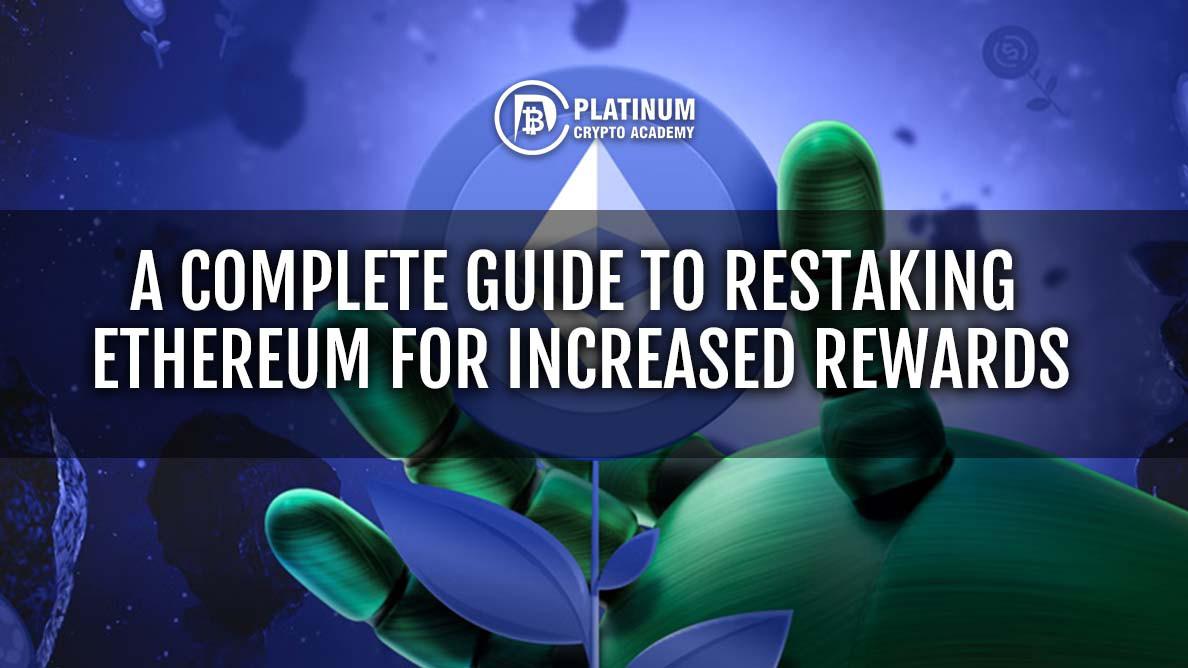
In proof-of-stake (PoS) blockchains like Ethereum, the network’s security is closely tied to factors such as the number of active validators, the percentage of circulating tokens staked, and how these tokens are distributed among validators. Restaking mechanisms play a crucial role in incentivizing holders of staked tokens, which would otherwise remain inactive, to actively participate in securing the blockchain.
Restaking involves various processes and strategies aimed at optimizing the utilization of staked tokens to enhance the overall functionality of the blockchain. This includes initiatives to encourage token holders to restake their holdings, thereby contributing to the network’s security and efficiency.
This article delves into the concept of restaking, exploring its different forms and mechanisms. We will discuss how restaking works, including the concept of liquid restaking, which allows token
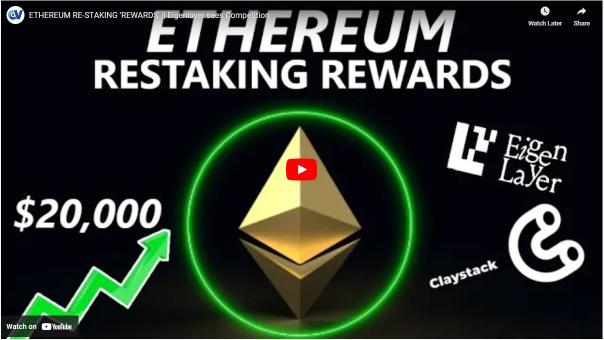
holders to maintain liquidity while staking their assets. Additionally, we will explore the concept of collective security using staked Ether, where validators pool their resources to strengthen the network.
What is restaking?
Restaking introduces an innovative approach to cryptocurrency security, allowing stakers to utilize their Ether more efficiently within the consensus layer. It enables stakers to amplify their rewards while bolstering the security of the staking network by facilitating the deployment of liquid staking tokens across multiple networks with validators.
Staked tokens typically remain inactive on proofof-stake (PoS) blockchains. However, restaking activates these staked tokens, resulting in higher staking rewards for restakers. Whether staking Ethereum directly or utilizing a liquid staking token (LST), individuals can employ a restaking protocol like EigenLayer to earn additional rewards on their staked tokens.
The Ethereum network stands out for its large number of validators participating in the PoS consensus mechanism. However, staked ETH remains dormant. With the introduction of liquid staking protocols, staked ETH is converted into fungible tokens, allowing stakers to use it in
Cryptonaire Weekly | April 30 th 2024 25
decentralized finance (DeFi) applications. This mechanism also bypasses the minimum 32 ETH staking requirement, enabling users with smaller holdings to earn staking rewards.
Types of restaking
Restaking can be broadly categorized into two types: native and liquid restaking. Native restaking is accessible to users who operate an Ethereum validator node. It operates through a series of smart contracts that oversee the management of assets staked within a validator’s node.
Here are the different types of restaking:
Direct Restaking: This method involves reinvesting staking rewards directly into the staking pool. Instead of withdrawing rewards, stakers choose to compound them by automatically restaking them. This compounds the rewards over time, leading to accelerated growth in staked assets.
Indirect Restaking: Indirect restaking entails using staking rewards to acquire additional tokens for staking. Rather than directly restaking the rewards, they are converted into additional tokens, which are then staked alongside the original holdings. This method effectively increases the staking balance and subsequently enhances rewards.
Liquid Restaking: Liquid restaking allows stakers to retain liquidity while still participating in staking. Instead of locking up tokens in a staking contract, liquid staking tokens (LSTs) are issued, representing staked assets. These LSTs can be freely traded or used in other DeFi protocols while still accruing staking rewards.
Validator Rotation: In networks where stakers have the ability to choose validators, validator rotation involves periodically changing validators. This strategy aims to diversify risk and maximize rewards by distributing stakes across multiple validators. Validators may offer different fee structures, performance records, and security levels, allowing stakers to optimize their returns.
Compounding Strategies: Compounding strategies involve actively managing staked assets to maximize returns. Stakers may employ techniques such as timing withdrawals and restakings to optimize reward accumulation. By strategically timing restaking actions, stakers can capitalize on
fluctuations in network conditions and token prices to enhance their returns.
Pooling Services: Pooling services allow stakers to combine their assets with others to create larger, more attractive staking positions. By pooling resources, participants can access higher-tier validators, reduce the impact of slashing penalties, and potentially earn higher rewards. This approach is particularly beneficial for smaller stakers who may not meet the minimum staking requirements on their own.
How liquid restaking works
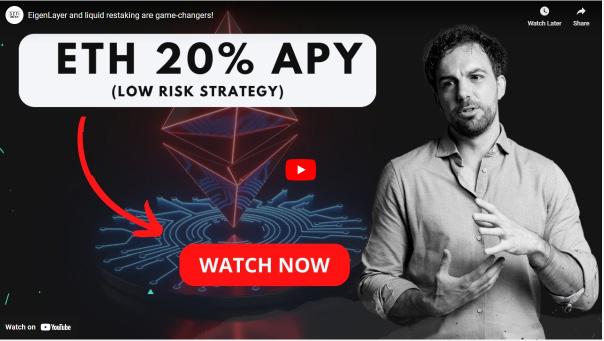
Liquid restaking is a mechanism that allows cryptocurrency holders to participate in staking activities while maintaining liquidity over their assets. Here’s how liquid restaking works:
Tokenization of Staked Assets: In liquid restaking, when a user decides to stake their assets, such as Ethereum (ETH), with a validator, the validator issues a corresponding amount of liquid staking tokens (LST) to the user. These LSTs represent the staked assets and can be freely traded or used in other decentralized finance (DeFi) protocols.
Flexible Asset Usage: Unlike traditional staking, where assets are locked up in a staking contract for a specified period, LSTs provide flexibility. Holders of LSTs can freely trade them on exchanges, use them as collateral for loans, or participate in yield farming and liquidity mining activities while still earning staking rewards.
Dynamic Reward Accrual: Staking rewards earned by the validator are periodically distributed to LST holders in proportion to their holdings. This ensures that LST holders continue to earn rewards based on their staked assets, regardless of how they choose to utilize their LSTs.
Cryptonaire Weekly | April 30 th 2024 26
Redeemability: At any point, LST holders have the option to redeem their tokens for the underlying staked assets. This process typically involves burning the LSTs, which triggers the release of the corresponding amount of staked assets back to the holder’s wallet.
Enhanced Participation: Liquid restaking opens up staking opportunities to a wider range of investors who may not want to lock up their assets for extended periods. By providing liquidity and flexibility, liquid staking attracts more participants to the staking ecosystem, thereby increasing the security and decentralization of the network.
Let’s take EigenLayer as an example to illustrate how liquid restaking operates. EigenLayer boasts a total value locked (TVL) of over $250 million, serving as a vital link between Ethereum and other blockchain applications. It provides both pooled security and a marketplace for it.
Restaking via Smart Contracts
EigenLayer serves as the foundational infrastructure for restaking. Individuals who have already staked their ETH—whether directly or through liquid staking solutions—can interact with EigenLayer’s smart contracts. This enables them to restake their holdings and contribute to the security of various platforms, effectively establishing a collective security mechanism powered by Ethereum.
Process for Restaking on EigenLayer
Restaking on EigenLayer provides an opportunity for cryptocurrency holders to actively participate in securing the network and earning rewards. The process involves a series of steps designed to ensure a seamless experience for users. In this guide, we’ll explore the process for restaking on EigenLayer in detail.
Step 1: Accessing the EigenLayer Platform
The first step in the restaking process is to access the EigenLayer platform. Users can do this by visiting the EigenLayer website and navigating to the top menu. On the right side of the menu, there is a button labeled “Restake.” Clicking on this button will open the EigenLayer app in a new tab.
Step 2: Logging In or Creating an Account
Once the EigenLayer app is open, users will need to log in to their existing account or create a new one if they are new to the platform. Logging in requires providing the necessary credentials, while new users will need to complete a registration process, which typically involves providing an email address and setting up a password.
Step 3: Navigating to the Restaking Section
After logging in, users should navigate to the restaking section within the EigenLayer app. This can usually be found in the main menu or dashboard. The restaking section is where users can view their current staking status, adjust their staking preferences, and initiate the restaking process.
Step 4: Choosing the Staking Option
EigenLayer typically offers multiple staking options for users to choose from. These options may vary based on factors such as the duration of the stake, the amount of cryptocurrency to be staked, and the expected rewards. Users should carefully review the available staking options and select the one that best suits their investment goals and risk tolerance.
Step 5: Confirming the Staking Details
Before proceeding with the restaking process, users should review and confirm the staking details. This includes verifying the amount of cryptocurrency to be staked, the duration of the stake, the expected rewards, and any associated fees. It’s essential to double-check these details to ensure accuracy and avoid any potential errors.
Step 6: Initiating the Restaking Transaction
Once the staking details have been confirmed, users can initiate the restaking transaction. This typically involves clicking a “Stake” or “Confirm” button within the EigenLayer app. Upon clicking this button, users may be prompted to confirm the transaction using their preferred authentication method, such as a password or two-factor authentication.
Step 7: Monitoring the Staking Status
After initiating the restaking transaction, users should monitor the staking status to ensure that it has been successfully processed. This can usually be done within the EigenLayer app, where users can view details such as the current staking balance, the status of the stake, and any rewards earned.
Cryptonaire Weekly | April 30 th 2024 27
Once the staking transaction is complete, users can manage their staked assets within the EigenLayer app. This includes tracking rewards earned, adjusting staking preferences, and withdrawing staked assets if desired. Users should regularly monitor their staked assets and make any necessary adjustments based on changing market conditions or investment objectives.
Utilizing Staked ETH for Collective Security
Traditionally, the launch of a new protocol entails establishing a network of trust for security, which includes setting up a group of validators and introducing a native cryptocurrency.
However, restaking revolutionizes this process by enabling these protocols or Active Validator Sets (AVS) to harness the collective security provided by Ethereum’s stakers, significantly streamlining development. These AVS, also known as EigenLayer modules, encompass various components such as sidechains, bridges, oracle networks, keeper networks, and data availability layers.
Previously, attackers could potentially compromise the security of an AVS to cause disruption. Yet, with EigenLayer’s pooled security model, any such attempt would necessitate challenging the entire collective stake, valued at billions of dollars. However, participating in EigenLayer’s smart contracts introduces additional risks, including the possibility of heightened slashing conditions for a user’s staked ETH.
For Ethereum stakers, this model offers the opportunity to earn higher returns by securing various AVS with their restaked ETH without the need for different tokens. EigenLayer facilitates this through a marketplace where AVS can attract the support of Ethereum validators, who can then select which modules to back based on the incentives provided.
Concerns Surrounding Restaking
One prevalent concern regarding restaking revolves around the repetitive allocation of funds to similar validators, which simultaneously increases both yield and risk. Developers have cautioned that excessive leveraging could lead to project instability. They argue that embedding more financial risk into
the blockchain itself could potentially destabilize the entire ecosystem. Vitalik Buterin, Ethereum’s co-founder, has warned that restaking protocols could expose the blockchain to significant systemic risk.
The rapid proliferation of restaking protocols means that associated risks are also escalating, demanding immediate attention. A significant failure could undermine the security of the underlying blockchain. In 2022, Ankr, a restaking protocol built on the BNB network, was exploited, serving as a stark reminder of the potential catastrophe for a blockchain network.
However, despite the risks associated with restaking, it can be deployed in scenarios with low-risk misbehaviors, such as double signing, without compromising Ethereum’s decentralization principles.
Emergence of Staking as a DeFi Component
As restaking continues to evolve, it is poised to emerge as a pivotal component of Decentralized Finance (DeFi), attracting more liquidity and users into Ethereum staking. Historically, Ethereum has lagged behind other Proof of Stake (PoS) networks in staking ratio. However, through the synergies of Liquid Staking Tokens (LST) and restaking, Ethereum’s staking ecosystem may experience significant growth.
The potential risks posed to layer-1 blockchains by restaking suggest a need for a cautious approach to the development and deployment of staking services. Addressing potential conflicts that arise after restaking becomes widespread will be crucial in preventing negative repercussions. By carefully considering the long and short-term effects of restaking on the Ethereum ecosystem, a win-win situation can be achieved for every staker.
Conclusion
In conclusion, restaking represents a significant evolution in the cryptocurrency space, offering new opportunities for users to participate in securing networks and earning rewards. Through restaking, Ethereum’s staking ecosystem is poised to grow, attracting more liquidity and users into the platform. However, it’s essential to remain mindful of the potential risks associated with restaking, such as
Cryptonaire Weekly | April 30 th 2024 28
Step 8: Managing Staked Assets
systemic vulnerabilities and project instability. By adopting a cautious approach and addressing conflicts as they arise, the Ethereum ecosystem can navigate these challenges and emerge stronger. Ultimately, restaking has the potential to become a key component of Decentralized Finance (DeFi), contributing to the continued growth and development of the cryptocurrency industry.
FAQs
1. What are the benefits of restaking?
Restaking offers several benefits to cryptocurrency holders. Firstly, it allows them to earn rewards in the form of additional tokens for securing the network. These rewards can be significant, providing stakers with a passive income stream. Additionally, restaking helps strengthen the security of the blockchain network by increasing the number of tokens staked, thereby making it more difficult for malicious actors to compromise the network. Furthermore, restaking encourages long-term investment in the cryptocurrency ecosystem, as stakers are incentivized to hold onto their tokens rather than sell them.
23. What are the risks associated with restaking?
While restaking offers many benefits, it also comes with certain risks. One of the main risks is the potential loss of funds due to slashing. Slashing occurs when a staker behaves maliciously or negligently, resulting in a portion of their staked tokens being forfeited as a penalty. Another risk is the possibility of network downtime, which can occur if a significant number of validators go offline simultaneously, leading to disruptions in transaction processing. Additionally, there is the risk of market volatility, as the value of staked tokens can fluctuate over time.
3. How can I mitigate the risks associated with restaking?
To mitigate the risks associated with restaking, it’s essential to conduct thorough research and choose reputable staking providers with a track record of reliability and security. Additionally, diversifying your staking across multiple validators can help reduce the impact of slashing penalties. It’s also important to stay informed about network upgrades and changes in staking protocols to minimize the risk
of network downtime. Finally, exercising caution and only staking an amount of cryptocurrency that you can afford to lose can help mitigate the risks associated with market volatility.
4. How do I get started with restaking?
To get started with restaking, you’ll first need to choose a cryptocurrency that supports staking, such as Ethereum or Cardano. Next, you’ll need to set up a wallet that supports staking or choose a staking provider to stake your tokens on your behalf. Once you’ve selected a staking method, you’ll need to transfer your tokens to your staking address and follow the instructions provided by your staking provider to begin staking.
5. How often do I receive staking rewards?
The frequency of staking rewards depends on the specific blockchain network and staking protocol you’re using. In most cases, staking rewards are distributed at regular intervals, such as daily, weekly, or monthly. The amount of rewards you receive will also vary depending on factors such as the amount of cryptocurrency you’ve staked and the current network conditions.
6. Can I unstake my tokens at any time?
In many cases, yes, you can unstake your tokens at any time. However, there may be certain conditions or lock-up periods associated with unstaking, depending on the staking protocol you’re using. Additionally, unstaking your tokens may incur a waiting period before you can access them, during which your tokens will remain locked up. It’s essential to familiarize yourself with the unstaking process and any associated terms and conditions before staking your tokens.

Cryptonaire Weekly | April 30 th 2024 29

Solo Bitcoin Miner Secures Entire 3.125 BTC Block Reward
Out of roughly 841,340 blocks created since Bitcoin’s inception 14 years ago, only 282 instances like this have been recorded.
A Bitcoin miner defied the odds by independently solving a network block 841,286, which allowed them to acquire a full 3.125 BTC reward.
The fourth Bitcoin halving took place on April 20 at block 840,000, reducing the block reward from 6.25 BTC to 3.125 BTC, which is currently valued at around $200,000.
Bitcoin Miner Solves 282nd Solo Block
On April 29, Con Kolivas, a software engineer and administrator from the solo mining pool ckpool, shared on X that a miner
Lido Achieves 1 Million Validators Amidst Declining TVL
Lido hits 1 million validators on Ethereum, a major boost for DeFi accessibility.
Despite milestone, Lido's total value locked falls by 25% to $29.78 billion.
Lido commands 28.5% of Ethereum stake amid DeFi's varied performances.
In a significant milestone for decentralized finance (DeFi), Lido Finance has now reached one million validators on the Ethereum blockchain.
This achievement highlights a major advancement in making cryptocurrency staking accessible to a broader audience. Typically, staking requires substantial cap-
(and not a large company) had solved the 282nd solo block in Bitcoin’s history, a rare case.
Kolivas noted that this solo miner had a significant hash rate of approximately 120PH (peta hashes) at the time, equivalent to around 0.12 EH (exa hashes), with an average of around 12PH over a week. This hash rate was roughly 0.02% of the total network hash rate.
Kolivas analyzed the block-solve summary and speculated that this large miner had either recently transitioned from pooled mining post-halving, likely due to no longer covering their electricity costs for pooled mining, in pursuit of a chance at a solo block.
Read more...

ital, as running a validator node on Ethereum necessitates holding at least 32 ETH.
Lido Announces Major Achievement While Its TVL Slips
Announced in a recent post on X, Lido Finance has emerged as Ethereum’s largest liquid staking protocol. This platform facilitates staking for retail users with less than 32 ETH.
Data from Dune reveals that more than 27.16% of all Ethereum
supply is currently being staked, primarily through protocols like Lido. This increase in staking participation is largely due to the liquidity benefits of liquid staking protocols.
Unlike traditional staking, where assets remain locked, liquid staking allows users to receive Lido Staked ETH (stETH), which can be utilized in various other DeFi protocols, enhancing liquidity.
Read more...
Cryptonaire Weekly | April 30 th 2024 30
Circle’s USDC Overtakes Tether
USDT In Transaction Volume: Visa
The data facilitated by Visa Inc. spotlighted USDC's recent monumental achievement. Circlebacked stablecoin USDC overtakes Tether USDT in transaction volume.
Circle Internet Financial’s stablecoin, USDC, has achieved a significant milestone in the stablecoin market. It has surpassed Tether’s USDT in transaction volume, as pointed out by Visa, a globally recognized
digital payments tech company.
This data was made available through a collaboration with Allium Labs, which spearheaded the development of a unique stablecoin metric. Visa, a trusted name in the industry, has vouched for this metric’s accuracy, designed to provide a clear view of the stablecoin market dynamics, free from potential distortions caused by artificial inflationary practices or inorganic activities.

Google Cloud’s Web3 portal launch sparks debate in
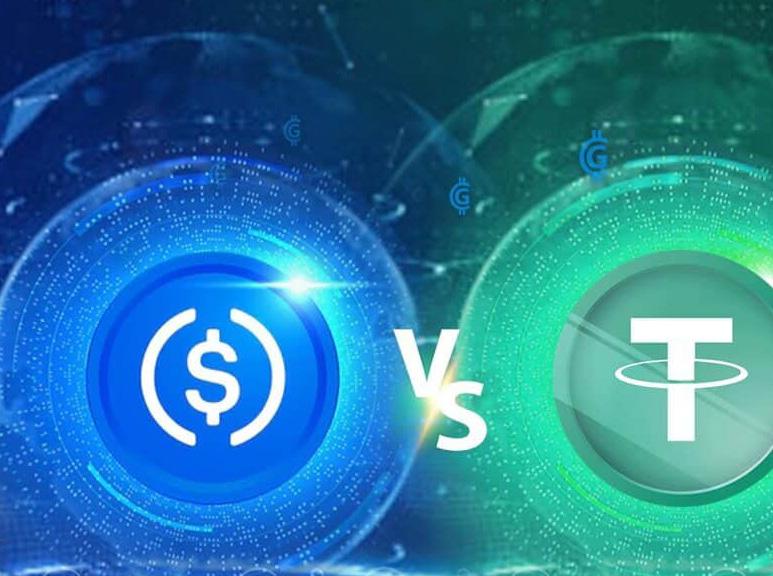
Here’s an overview of the data streamlined by Visa’s stablecoin-specific metric that underscores USDC’s monumental achievement.
USDC Reigns Supreme Despite Less Dominance In The Market
According to Visa’s data, Circle’s USDC has not only gained significant traction in the market
Google Cloud recently launched a Web3 portal with testnet tools, blockchain data sets, and learning resources for developers, and it has received mixed reactions from the crypto industry.
Google Cloud has introduced a new Web3 portal with resources for blockchain developers, including data sets and tutorials on creating nonfungible tokens (NFT). However, the reception within the cryptocurrency industry has been mixed.
“No native Bitcoin and lightning support? Seems like an oversight to ignore the most important cryptocurrency,” vice president of product market-
since its inception in 2018, but has also made a global impact since the beginning of 2024. Last week alone, USDC registered a staggering $456 billion in transaction volume, a figure that overshadows Tether’s USDT, which trailed behind at $89 billion, underlining the magnitude of USDC’s success.
Read more...
ing at Unchained Phil Geiger stated in an X post on April 25.
“Not impressed Google is way behind,” pseudonymous crypto trader MartyParty told his 80,700 X followers on April 26.
Meanwhile, others were more receptive to the launch. Mitroplus labs founder Ivaibi Festo described the Web3 portal as a “comprehensive resource” in an April 25 post on X.
According to its website, developers can access a range of products and receive testnet tokens to deploy and test their decentralized applications on Ethereum testnets Sepolia and Holesky.
Read more...
Cryptonaire Weekly | April 30 th 2024 31
crypto industry
Binance's CZ Will Spend Less Than a Year in Prison, Polymarket Traders Bet

Also, the CFTC wants to bar Americans from betting on elections –even though it's already illegal in most U.S. states.
This week in prediction markets:
Polymarket bettors think Binance ex-CEO Changpeng "CZ" Zhao will spend less time in prison than what the U.S. DOJ is asking for.
The CFTC weighs a ban on election derivatives. How low will the Federal Reserve go?
Binance's founder and former CEO, Changpeng "CZ" Zhao, will be sentenced in a U.S. court in Seattle Tuesday. The Department of Justice said in a recent sentencing memo that he should spend three years in prison, citing the scale of
Hong Kong Spot Bitcoin ETF Success Rests On Asian Crypto Users
Hong Kong Bitcoin ETFs would see competition from other jurisdictions like Japan and South Korea. BTC price lacks catalyst ahead of launch.
his misconduct.
Polymarket bettors think he'll be out much sooner.
"Yes" shares for the "less than six months" contract on the cryptobased prediction market platform were trading at about 42 cents Monday, indicating a 42% chance CZ will be out in less than six months. (Each share pays out $1 if the prediction comes true, and zero if not.)
Trading levels show a 17% chance he'll get 6-11 months, and a 19% chance that he'll get 12-17. All in all, the money says there's around a 96% chance that he'll be out in less than two years and a less than 2% chance he'll get sentenced for 30-35 months, which is around what the feds are asking.
Read more...
The much-awaited spot Bitcoin ETFs will now come to the Hong Kong market tomorrow, April 30, as per the scheduled launch. China’s leading asset managers, HashKey Capital and Bosera, are on the brink of launching Hong Kong spot ETFs and are currently making final preparations. However, one major question in everyone’s mind is whether the Hong Kong Bitcoin ETFs would be able to replicate the success seen in the US.
Hong Kong Bitcoin ETF Launch
In an update from Bitcoin analyst Willy Woo, anticipation surrounds the imminent
launch of the Hong Kong Bitcoin ETF set for tomorrow. Drawing attention to the significant market landscape in Asia, Woo highlights a notable trend: the user count in Asia surpasses that of both the US and European markets combined. This revelation underscores the substantial influence of Asian investors in the cryptocurrency sphere, suggesting a robust market presence despite their smaller physical stature.
The Asian crypto community is one of the most active crypto communities in the world. However, one major bottleneck to the Hong Kong Bitcoin ETFs would be that the Chinese money won’t be able to enter amid the strict ban on digital assets in mainland China.

Cryptonaire Weekly | April 30 th 2024 32
Read more...

WWW.PLATINUMCRYPTOACADEMY.COM



 Karnav Shah Founder, CEO & Editor-in-Chief
Karnav Shah Founder, CEO & Editor-in-Chief












































